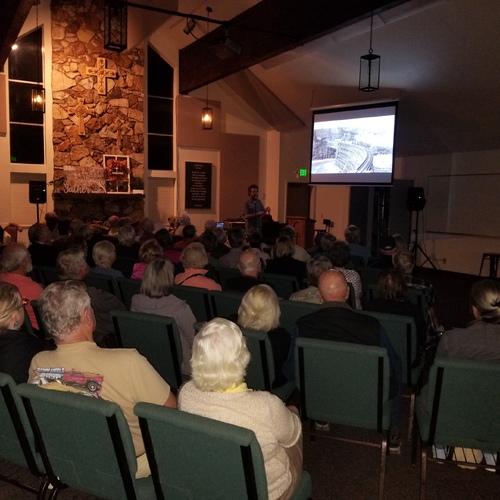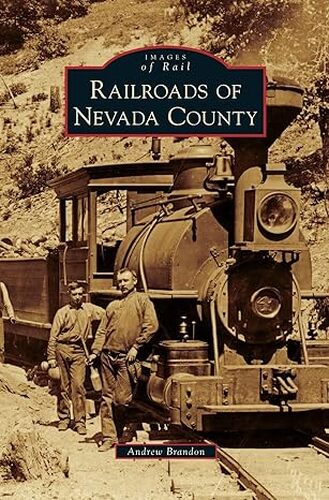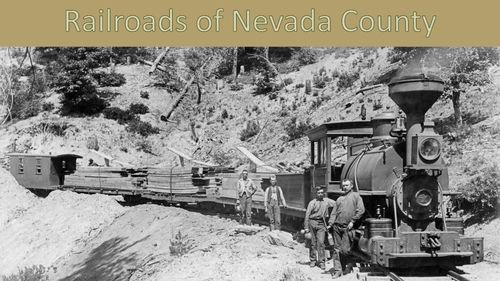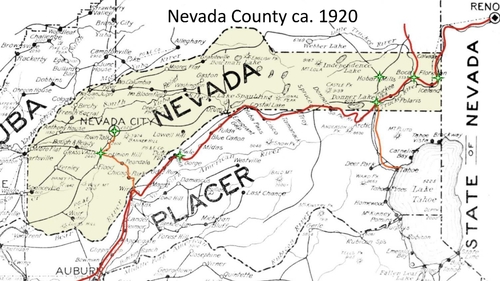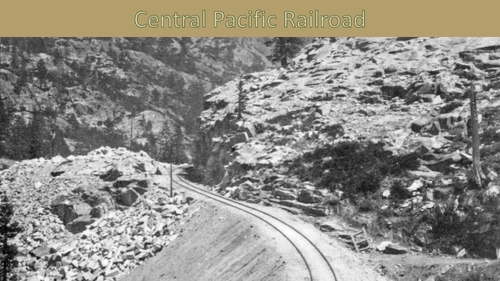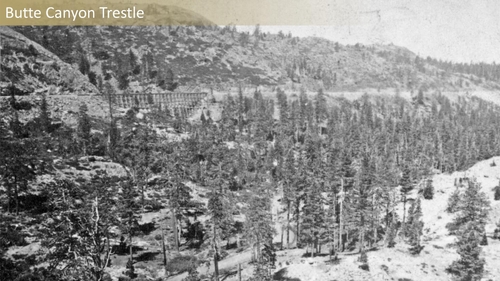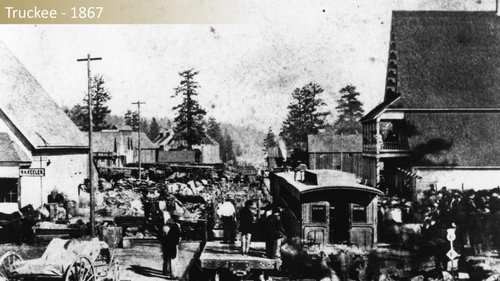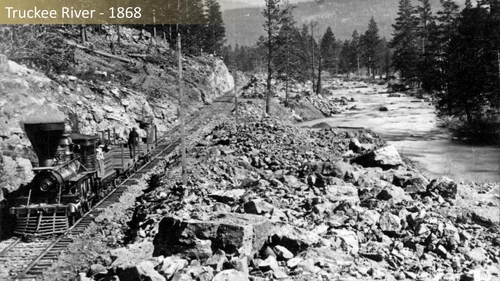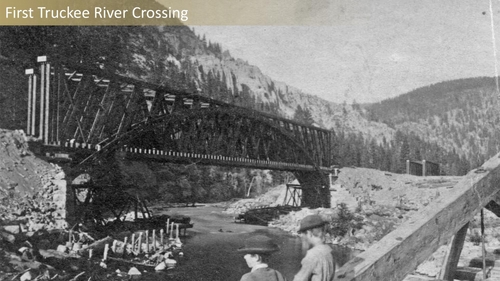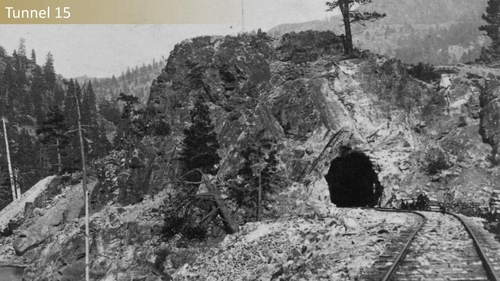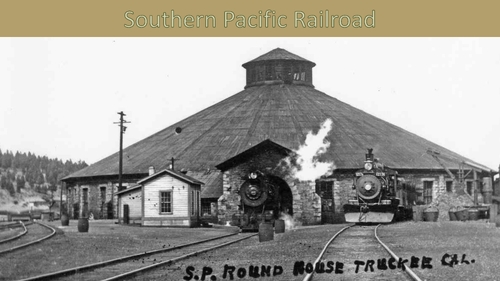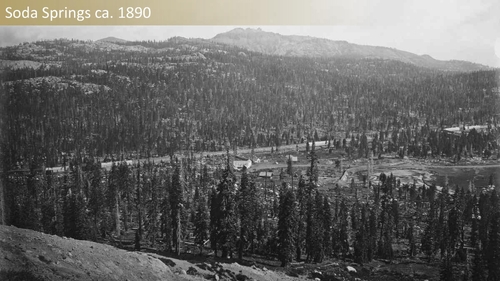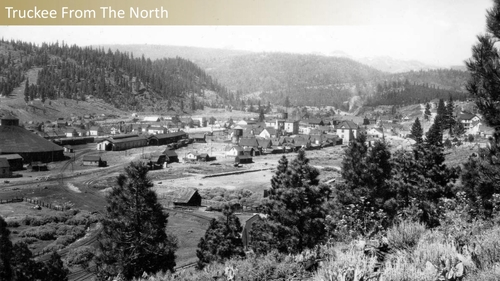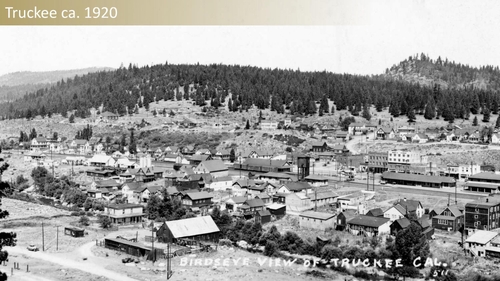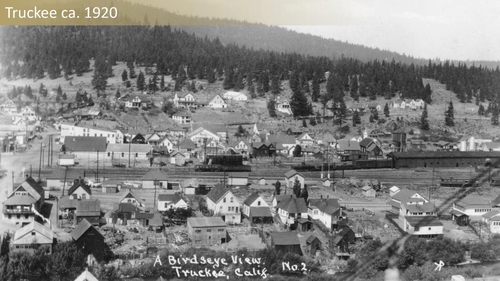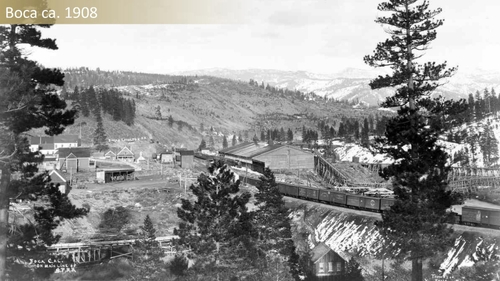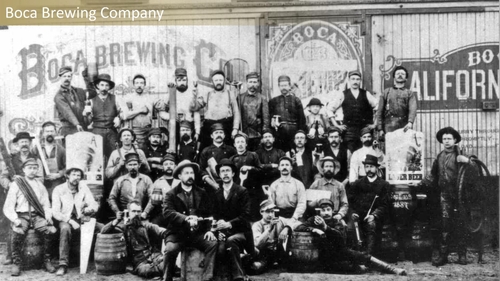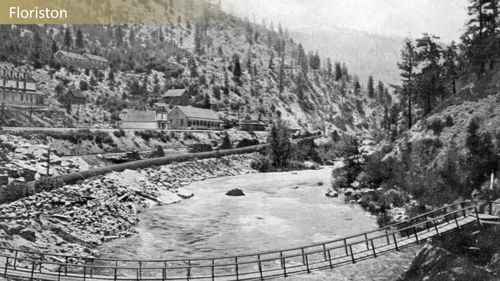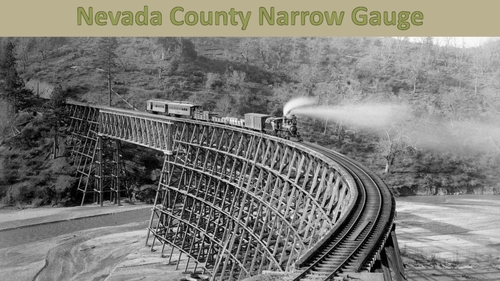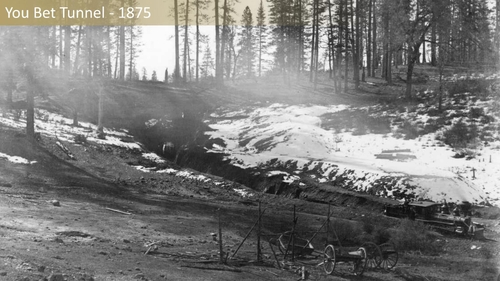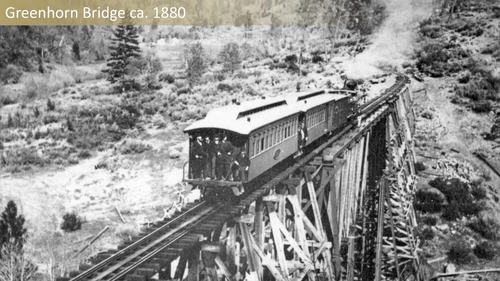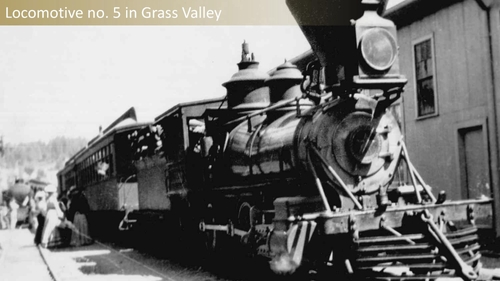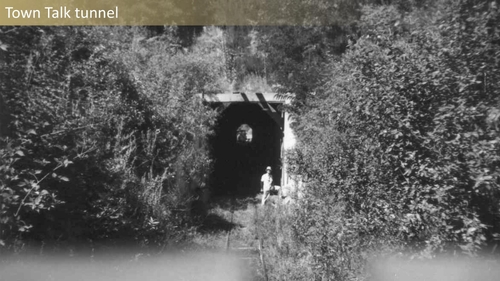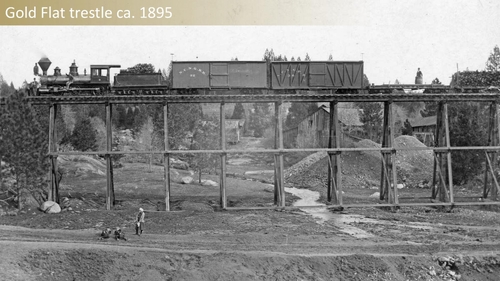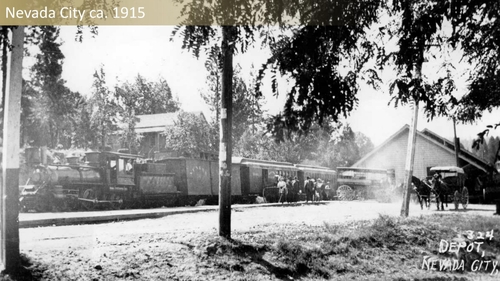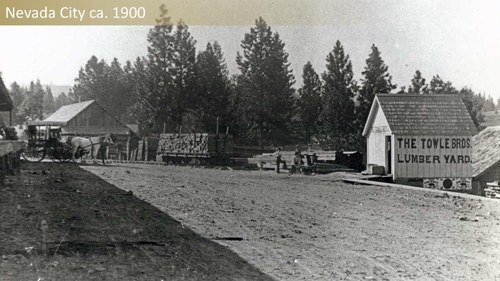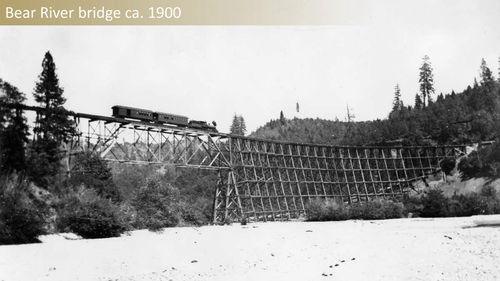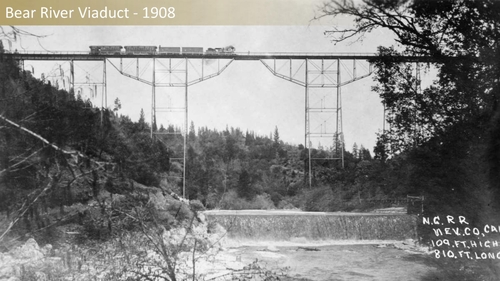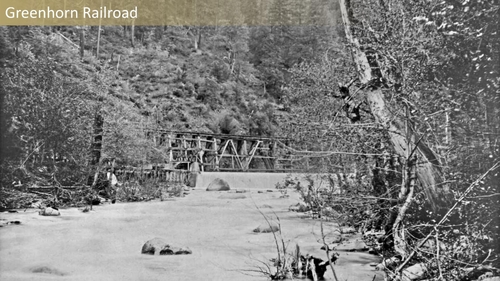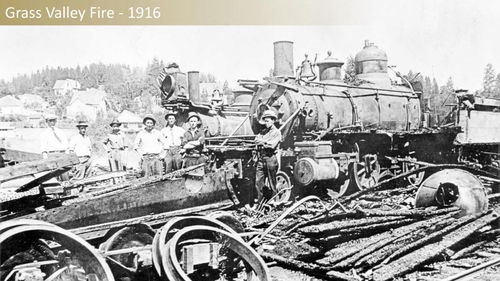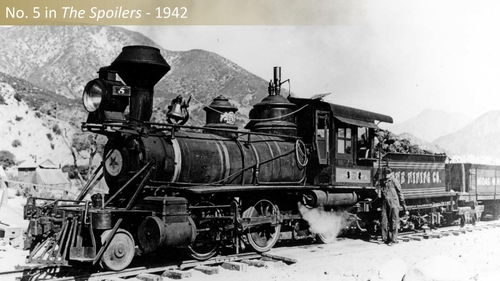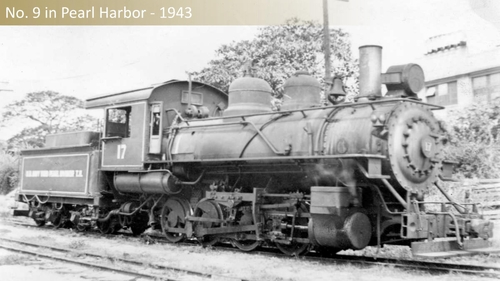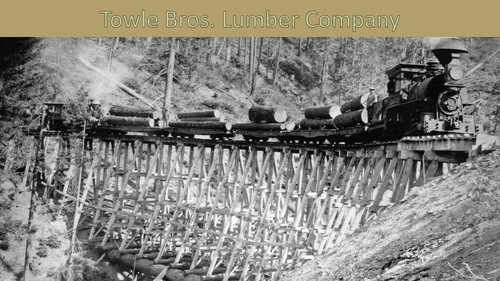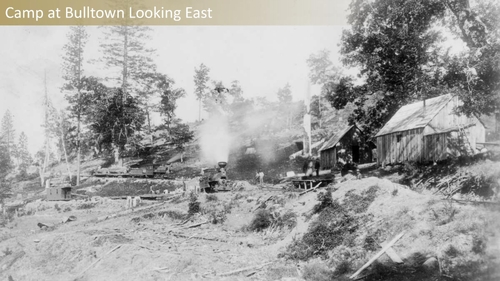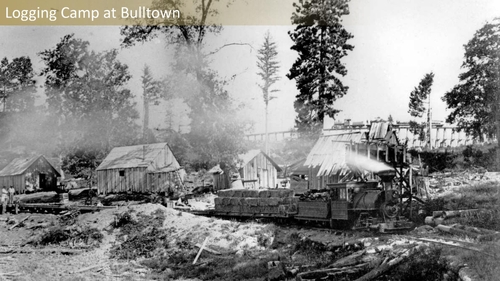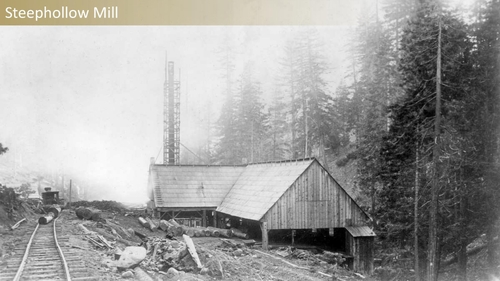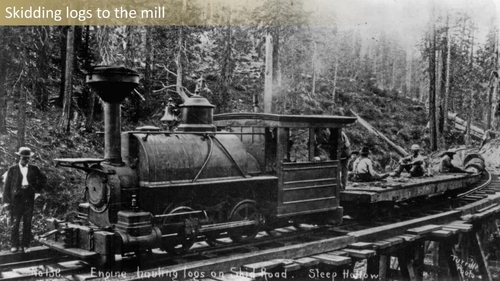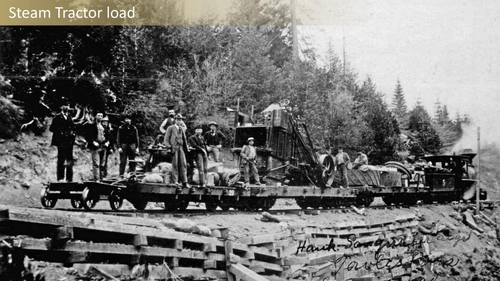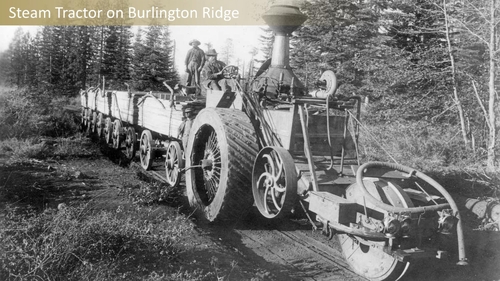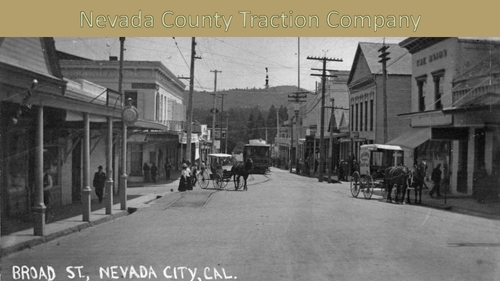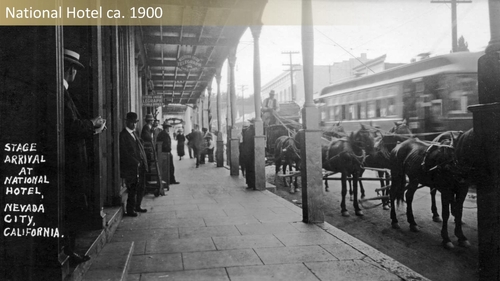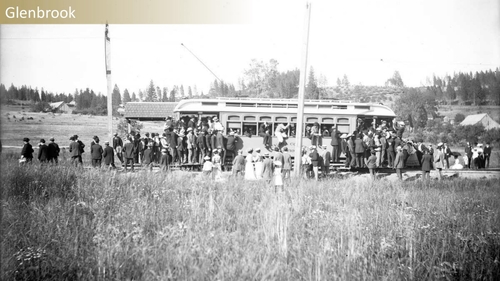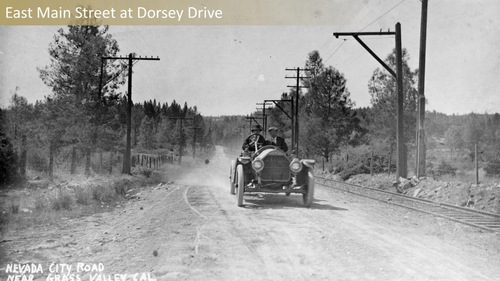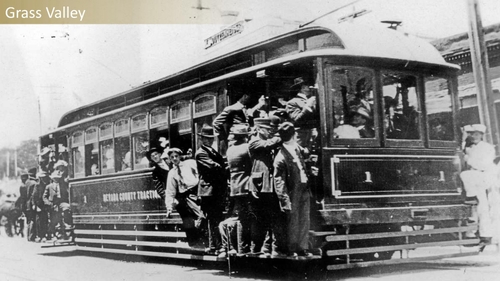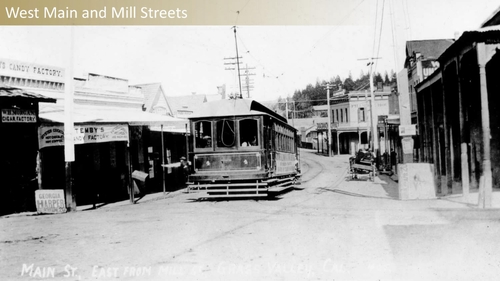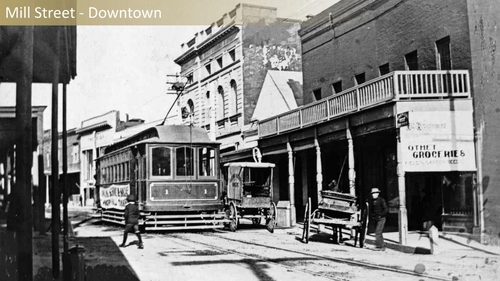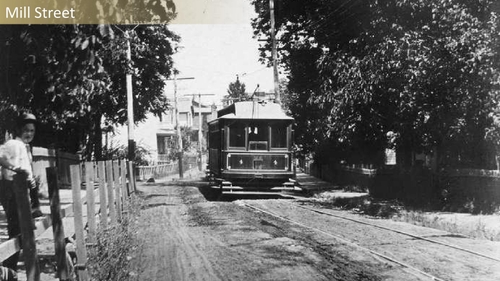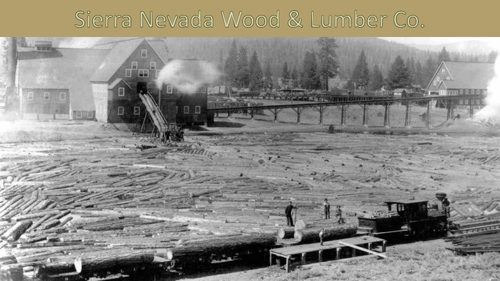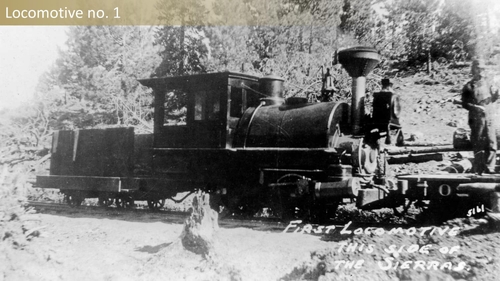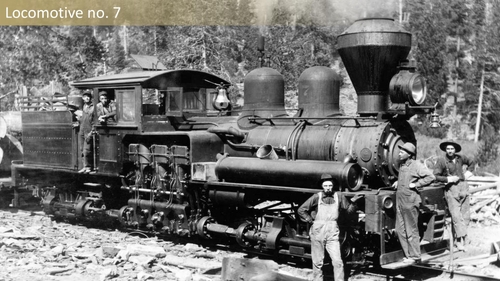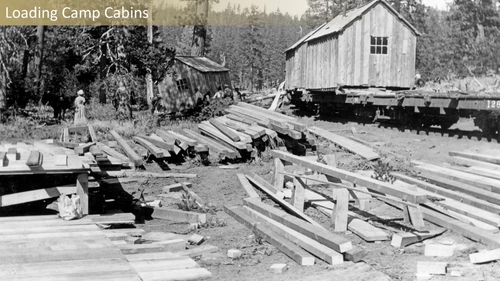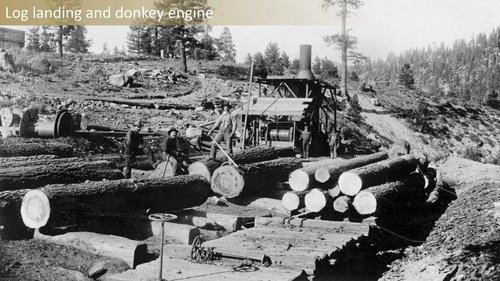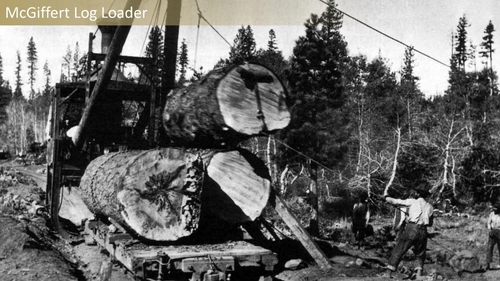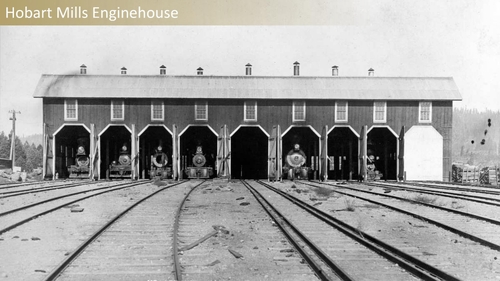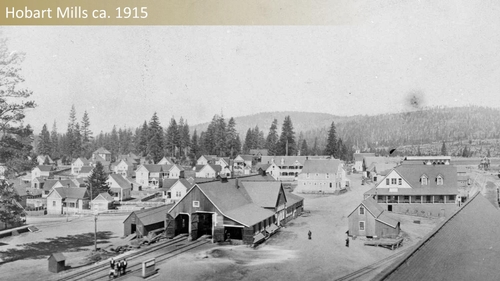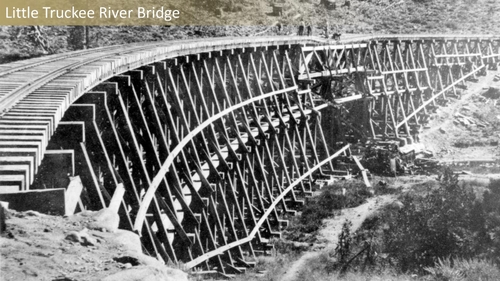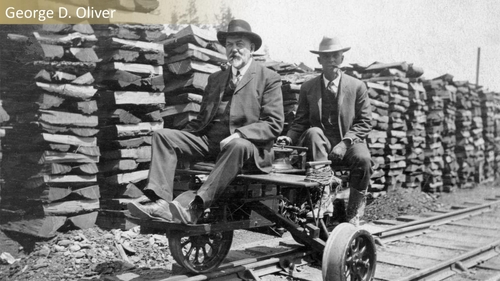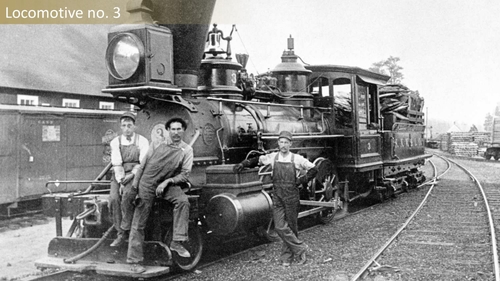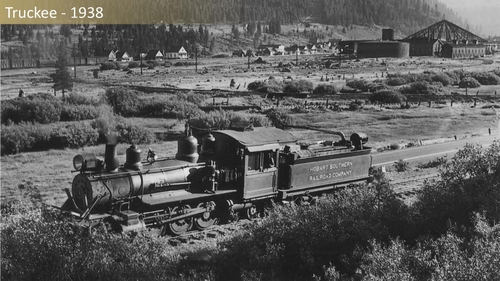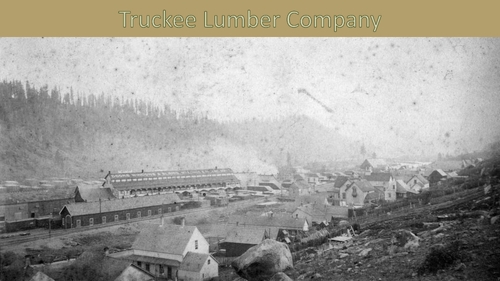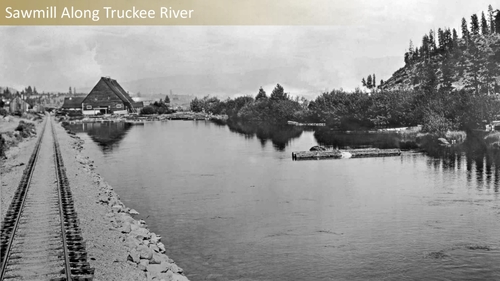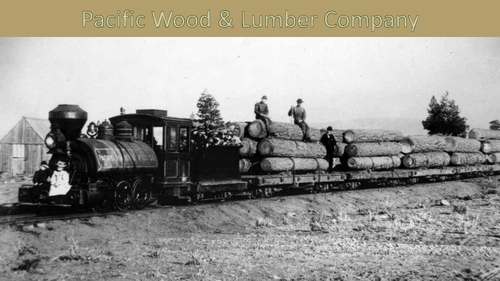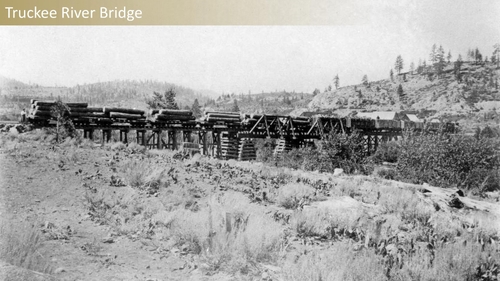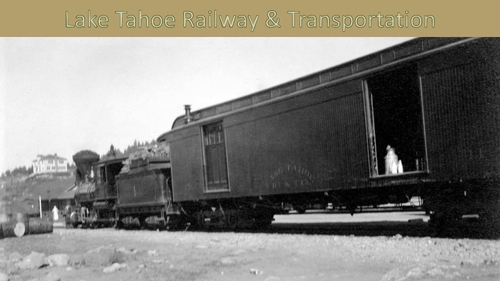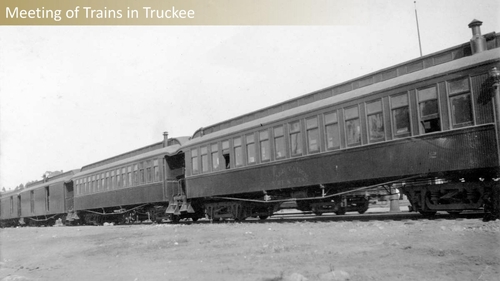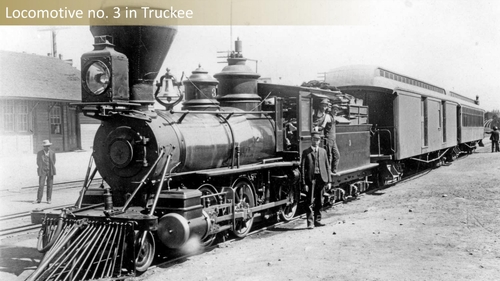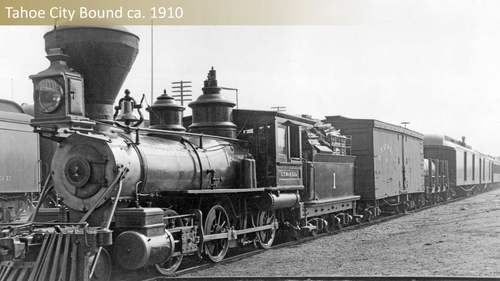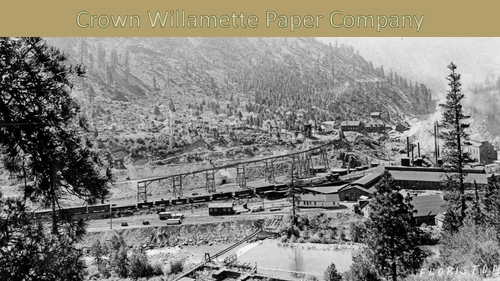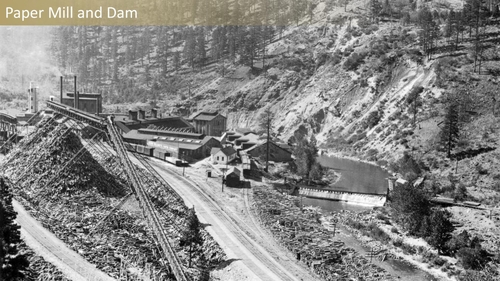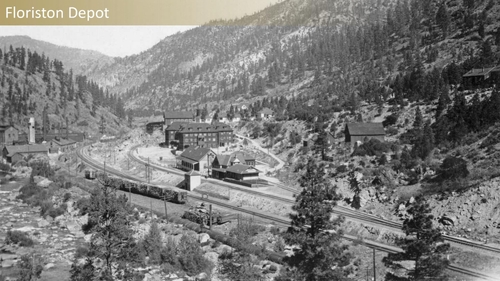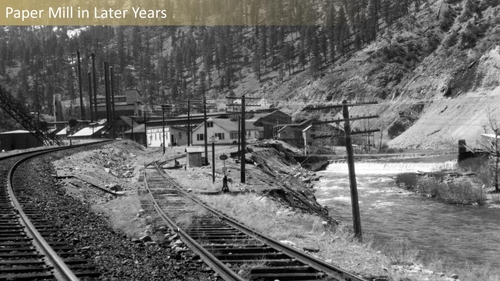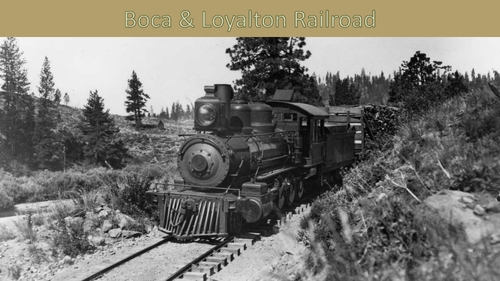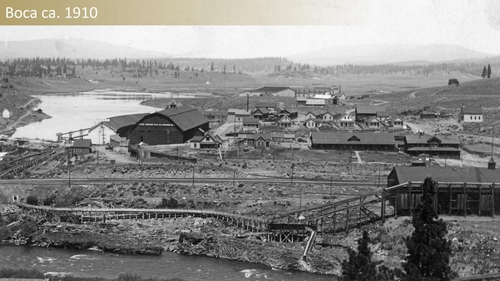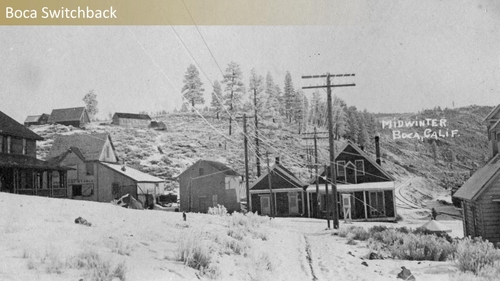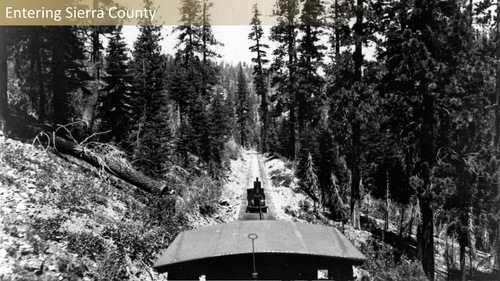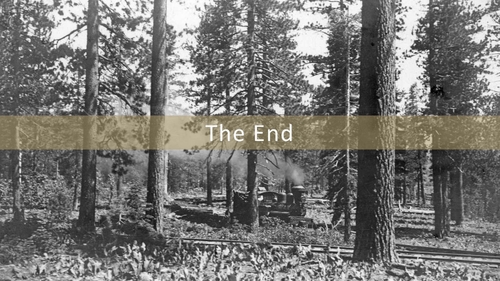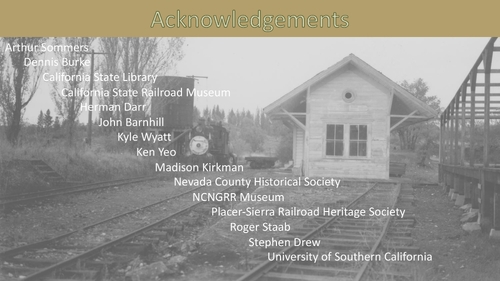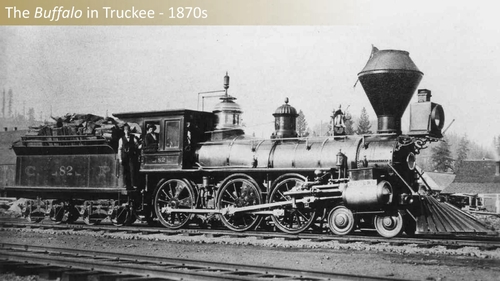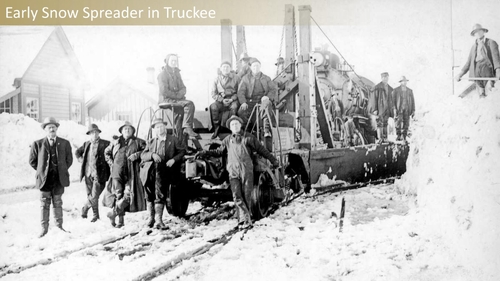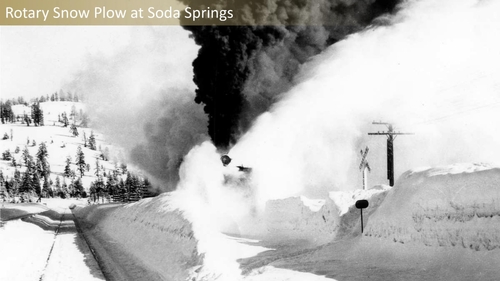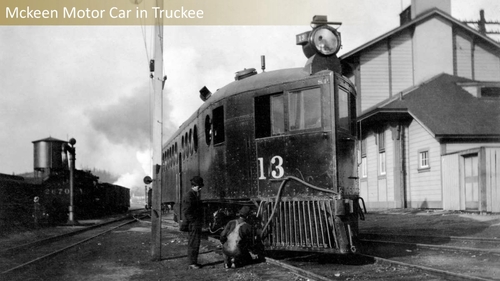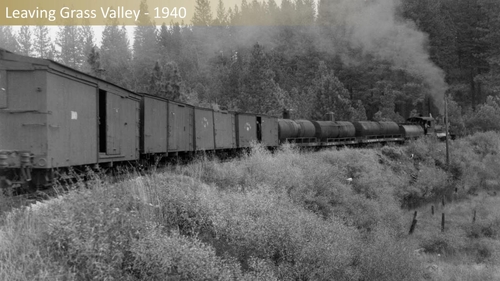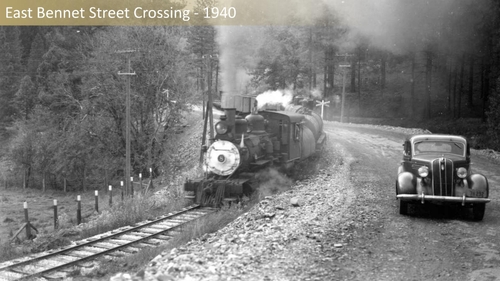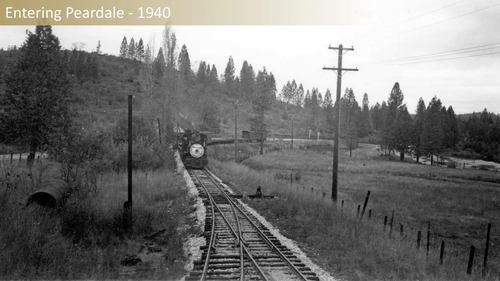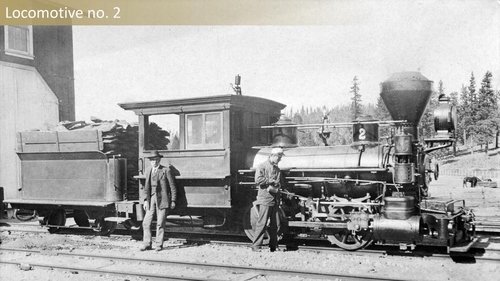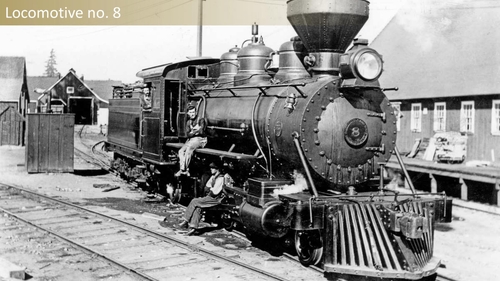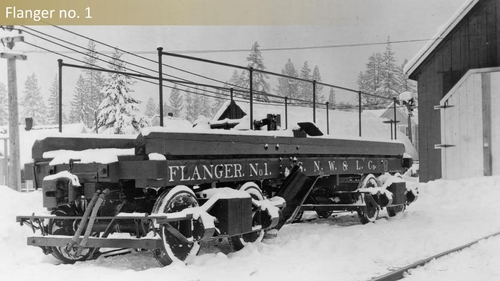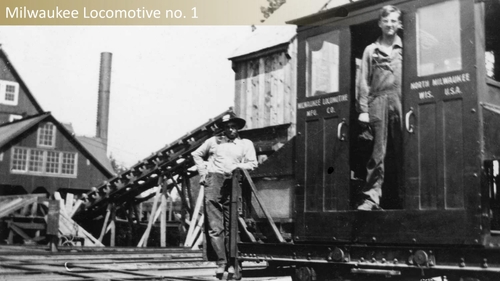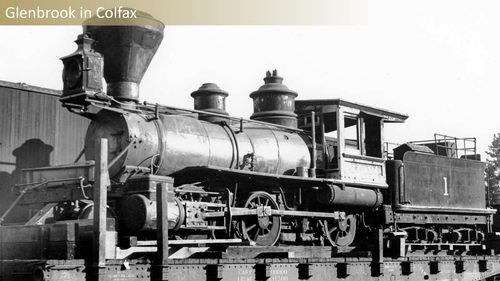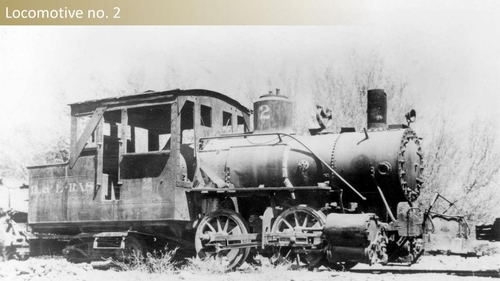Enter a name, company, place or keywords to search across this item. Then click "Search" (or hit Enter).
Collection: Videos > Speaker Nights
Video: 2023-10-19 - Railroads of Nevada County with Andrew Brandon (74 minutes)
Andrew Brandon will present a look at historic photographs from his book “Railroads of Nevada County”, which was released in 2018. The book presents a brief history of eleven different railroads that operated within Nevada County from 1866 – 1996. For nearly 20 years Andrew has been researching the Nevada County Narrow Gauge Railroad and collecting photographs and documents for an upcoming book on the railroad. The material collected for “Railroads of Nevada County” was born out of this research including many photographs which have not been published before.
Author: Andrew Brandon
Published: 2023-10-19
Original Held At:
Published: 2023-10-19
Original Held At:
Full Transcript of the Video:
I'm going to introduce Brandon, Andrew Brandon. I think he's going to talk about himself a little bit in terms of your history with the railroad museum and the history of the railroading. We're thrilled to have him tonight and he's guaranteed an excellent picture show and a lot of pictures. So, looking forward to that. I'll turn the lights off so you turn them a little better. Okay? Thank you, Andrew. Thank you for the introduction. So, my name is Andrew Brandon. I have been a volunteer at the Nevada County Narrow Gage Railroad Museum since April of 2002. I first visited the museum in a dedication in December of 2001. I was brought there by a number of former volunteers who have since passed away and some who are still with us. I have been very diligently since I started there researching the Nevada County Narrow Gage. Now, we have two wonderful books on the Nevada County Narrow Gage. It may surprise you to find out that there's quite a bit more that hasn't been talked about yet. I have a number of photographs and things that have only recently come to light. I have amassed a substantial collection of Nevada County Narrow Gage photographs, documents, and other records and information over the years. That is all going to go into a future book on the Nevada County Narrow Gage, a much larger book than the current one that I have for sale. But this book came out of the final chapter for that book. I wanted to talk about the other Narrow Gage railroads in Nevada County because we had one that had it in the name, but there were several others. Over the years of collecting information, it became obvious, okay, I've got a little too much to include in one chapter, so I wrote this little book, Railroads in Nevada County. Let me get that started here. Now, I will apologize. I have not given this talk since the book first came out in 2018, and I had to make a brand new presentation for you all. If you see me run over here to this pile of notes, it's because I forgot something, but there's so much to cover in 45 minutes, I'm going to try and be sparse on this. This is one of my favorite photographs. It's the cover photograph on the book. This is the Toll Brothers Lumber Company, near Lowell Hill. This is a very typical Toll Brothers lumber train. This is rough lumber coming from the mill at Steve Hollow Creek. As typical for Toll Brothers, it's three little flat cars. They're all different manufacturers and the caboose. A professional photographer came through the area in the early 1890s and shot these photographs. We'll see a few more as we go on. One of the important things to talk about is we have, I made this wonderful map that I colorized for you guys. The old version of this slide was just a black and white map and you couldn't figure anything out. This time I hope it helps a little bit better. I marked little stars where I'm going to talk about specific locations, Boca, Hobart Mills, Truckee, Floristan, the Town of Toll, Grass Valley, and Nevada City. The red line here is the Central Pacific Railroad, obviously the first railroad to build into Nevada County. Then we have two narrow gauge lines showing the Nevada County narrow gauge and the Laytahoe Railway shown here. This red line here is the Boca and the Loyalty. We'll learn more about that in a bit. We start with the Central Pacific Railroad. It was founded in 1862. It took several years of construction and planning before they finally reached Nevada County in 1865. This particular photo is showing Rattlesnake Mountain in the back. This is the oldest photograph of the railroad entering Nevada County. The county line for Nevada County was just behind the photographer. This is when the terrain on the railroad started to get rugged. This is the first area when the Central Pacific was building that they actually had to bring in Chinese laborers that came to begin the work of building over the past in this section. Today, unfortunately it's kind of cropped off in my view, up on the top of Rattlesnake Mountain over here is the next peak over was Red Mountain. That is where there's a fire lookout built by Southern Pacific much later that if you're adventurous you can get up there and find out or take a look at. This is another great view. These were all taken by Alfred A. Hart who was a photographer hired by the Central Pacific to come out and photograph the construction of the railroad. This particular view, you're looking at Crystal Lake is down on this side, the Crystal Lake Station. This is the Butte Canyon Trestle which today is a very modern steel tressel that Union Pacific still runs over. Down here in the foreground, this is the Dutch Flat Wagon Road, the original route that almost became the railroad over Goner Pass. Today, I-80 runs right through the middle of this photo. The railroad had a tough time building over the pass. To alleviate some of that and to reach Truckee which was the eastern terminal point of the railroad, they actually sent some equipment over to found Truckee and start building east part out there. Now, this photo is taken in 1867. By this time, the Central Pacific has started building the first enclosed roundhouse which you can see back here. That was an all wood structure and it later burned down in the 1880s and was replaced by something more significant. This is also the basic freight station platform here and you have a regular service train that's headed towards Reno right here. This photo is taken along the Truckee River in 1868. The locomotive in this photo was named the San Mateo. It came second hand from a railroad called the Western Pacific, the first Western Pacific railroad which actually was built from Sacramento down to Alameda or Oakland and was the actual Western terminus of the transcontinental railroad. Not a lot of people realized that there were three sections and Central Pacific was kind of the middle section. This locomotive along with eight flat cars and one coach were disassembled all over the mountains before the summit tunnel was built, reassembled in Truckee and the San Mateo was the first locomotive to operate east of Truckee into Nevada. Now one thing of note about this little stretch of railroad here, the very prominent young man whose name we probably all recognize, a man by the name of John Kitter, was given the assignment of surveying this section of the railroad from Truckee to Stateline, one of many projects he was involved in in the state. This is the first crossing of the Truckee River, Central Pacific preferred these beautiful Howtruss bridges, all wooden bridges across, this is the second crossing down here. Later on by the time, I want to say 1870, by the time they finished the transcontinental railroad, every one of these bridges on the Central Pacific was enclosed in wood siding. So these all became covered bridges all the way out to Ogden. This is tunnel 15, which is the last landmark before you leave Nevada County and you very briefly would enter Sierra County before you get to Stateline. Today this tunnel is no longer here, it was daylighted and removed, there's kind of a little place, you can see a little bit of the bluff from the freeway if you're ever out in that particular section, but this is the very end of the Central Pacific in Nevada County. Now one of the things, and I forgot to mention this, when I started this book project I discovered that another local pair of historians, Art Summers and Roger Staub, were working on a book called Railroads of Placer County. So we compared our notes and we decided to make them kind of a paired set, so everything I cover is only in the Nevada County itself and when they cross over to Placer County I supply materials for that book and so forth. So our coverage of the Central Pacific will kind of end here for now, but we're going to look forward to the Southern Pacific Railroad. The Southern Pacific was a project that started in the Bay Area in the 1860s and by 1869 the big four who were in charge of the Central Pacific acquired that company, reorganized it and it became later on known as the Southern Pacific Company which had the Southern Pacific Railroad and the Central Pacific Railroad all under one umbrella. So by this time, actually by the time that this roundhouse was built in 1885 the Southern Pacific Railroad was in charge of everything. Now I mentioned previously that there was the wooden roundhouse in Truckee. After it burned down they built this wonderful structure which is one of several that the railroad built. They built one in Houston, they built one in Los Angeles, the one in Truckee and to an extent the one in Rockland was similar. The stone for this building was quarried in Rockland and shipped up to Truckee to be built. That building lasted into the 1930s and it's a totally enclosed roundhouse. The turntable is inside to prevent everything from being covered in snow. You can see one of the locomotives is coming out on the outside track and this photo also dates from about 1900 because there is a coal loader here and by 1905 Southern Pacific switched most of the locomotives over to Bartlewood. So we're back up on the summit again. This is Soda Springs. Now Soda Springs was an early resort destination on the Central Pacific Railroad. This is a really nice view from about 1890 looking down at that resort right here. You can see here there's a long line of snow sheds built over the railroad. That whole section of the railroad by 1890 was totally enclosed in wooden snow sheds. You can even see a little enclosed walkway here. So if you've gone off the train, you've walked down, you came down here and you stayed. A couple of these little buildings I seem to recall are still present up there on top of the mountain. I don't know if they actually date back to the construction of the railroad before but there are a few up in this little area. Now here's a great view of Truckee. This is from about 1910. This is kind of an interesting view because we're looking down from where the modern road is down into Truckee. Here's the big engine house. Then there's also some other steam up sheds, a car shed. Right here is the end of the main line for the Sierra Nevada wooden lumber company and their little freight depot right there. Then also here was the big balloon track which is now a shopping center in Truckee. They've kind of turned that into it. It kind of follows the circle path to pay tribute to what was there before. Now this is a two part set of postcards. I wouldn't be surprised if there's a third one. I just haven't found it yet. But this is looking down into downtown Truckee. This is again about 1920 because you've got the bulk oil facilities here. You can see here's the passenger depot. That's the little freight depot that's still, or I'm sorry, that's the freight depot. That is the passenger depot. This is the Southern Pacific Railroad Hotel. If you're traveling over overland you could stay here. A lot of railroad crews did stay at that hotel. Then you've also got a couple little freight sheds. One of these should be an ice house. I think this one's the little ice house. Truckee has changed quite a bit since then. We're going to take a look at the next part of the scene. We're approaching to where the round pass is over here. Again, there's another bulk oil plant, one of the several water towers that serve both railroads in Truckee. A little agent's house, there's a passenger car here used as a bunk car. There's actually two of them. Amazingly, those two cars still exist in Truckee. They've been put butt together. They're a really long house along the side of the railroad track that if you don't know what you're looking at is both of those little cars. We're going to move east down the main line and we're going to approach the next prominent town on the railroad, which is Boca. Boca was a substantial area for harvesting ice. In this photo you can see the Union Ice Company facility right here. In the winter they would cut the ice out of the nearby lakes when they froze. You would store them in this ice house year round for as long as possible. You would insulate it with sawdust and that allowed you to pack to send fruit across the country or other perishable goods. Boca was very important for the railroad. This is one of five different locations on the central Pacific and the mountains that have significant ice houses. Also of note in here is a little note about the Boca and Loyalton Railroad, which is kind of running up here. There's a little switch back down to the station. That's the enclosed water tank for both railroads. There's actually a train on the Boca and Loyalton. Now we'll talk about the Boca and Loyalton later. The other important industry in Boca for many years was the Boca Brewing Company. The Boca Brewing Company was nationally renowned. They actually won, actually they were internationally renowned. They won a medal in Paris, I believe in 1893. The company got its start in about the 1870s and eventually built a very substantial brewery right where I-80 is as you come up to Boca. Unfortunately there's nothing that remains outside of a couple little foundations. They were significant enough that they operated their own refrigerator cars. That is the Boca Brewing Refrigerator Car or Insulated Box Car. It must have been a beautiful car. There's a bear. That's their company logo was a bear walking through the woods. All of these guys, they've all got a nice pint of beer and they're very proud of their craft. They can see that in color or more of the brewery but there's only a handful of pictures of the brewery and this is the only picture of one of the cars. Further east we reach Floriston. Now originally Floriston was little more than a railroad camp but as the years drew on it became a little more significant. So a dam was built upstream to channel water into this. This is an all wooden pipe to move the water actually down to an industry that popped up. There was a paper company in Floriston. In this photo you can actually see the Floriston Depot is right here. This is the Floriston Freethouse in the store. This is the early version of the hotel and by this time the photo is in about 19-12. There are two main lines so the original main line is the lower one and the new main line is the upper one. Now today this is almost unrecognizable as you go to MIA. Everything's been reworked. The tracks are still in the same place but none of these buildings outside of maybe this one or parts of this one are still there. This lovely little bridge here led to the other side where there's a second little dam temporarily that was replaced with something more significant later. So that's going to cover it for Southern Pacific right now. We'll see some more of that stuff in a bit. So we all know and love the Nevada County New River Bridge. I work on it. We have volunteers here who work on it. And this is a lot of the photos that I'm showing in this talk are kind of my favorite photos out of the book. This is one of my favorite photos of the Nevada County New River Bridge. This was taken in 1886. This is the Bear River Bridge. It has recently had a little bit of work on it. The cars here are very interesting because this car right here was essentially a stock car for hauling pigs down to Colfax. And this car up front was a custom built by the railroad as a black powder car. There was a black powder company in Nevada City. There was one of the first industries on the Nevada County narrow gauge. And they built two of these little cars that are outside braced and kind of interesting looking just to haul that black powder down to Colfax. Now this is one of the earliest photos of the railroad. A lot of times we see photos that have a date on them that someone wrote later that says 1875. Almost none of them are 1875. There's about six photos that date from that era. And this is one of them. This is a Nevada County narrow gauge number two still wearing its as built paint job. So this is 1875. It was used in construction heavily in 1875. And this is the U-Bet Tunnel. This is a nice view. You can see the track going all the way through the other side. If you have been to Rollins Lake, you know that there is a boat launch on the far eastern side of the lake. That boat launch is right up on top. And the ramp comes down here. When the water is low, you can actually see the cut for where this tunnel is on the other side. Otherwise, the rest of the railroad grade is underwater. This is a great shot of the next big landmark on the railroad. This is the Greenhorn Bridge. This photo dates from about 1880. One of these gentlemen, I believe it's this gentleman we think is John Kitter. The reason I'm a bit of a nerd for paint, historic paint. And I know the date on this photo because in 1879, at the end of 1879, the railroad changed their paint scheme on all the passenger cars to match them for Pacific. And that's what we're seeing here. So the earliest this could possibly be is 1880. And it's a very wonderful view of what that area looked like before they built the dam. And you'd be hard pressed to see that much of the canyon anymore outside of them totally draining the lake. The railroad continued on around through here. This is up towards into Chevelies. Chevelies pond and he had a little park down there. And the railroad kind of goes up right here and gets to a place we know as Chicago Park. Chicago Park was established in the 1880s as sort of a planned community from farmers being displaced around Chicago that were interested in the agricultural business and the promoter would sell them cloths of land for this wonderful agricultural area. So the very first Chicago Park Depot is this little tiny building that over the years sat here. This is close to, not next to Highway 174, but it's nearby. Over the years, the railroad picked that building up and moved it four times. And at the very end of its life, it became the post office in Paredale next to the railroad agent's house. The locomotive in this photo is Nevada County 5. And this is about 1900, a year after it arrived, as was mentioned previously before the talk that number five is still with us and operates. It's the second Sunday of every month over our Roman Museum during the summer. Here's another great picture of number five. This is still about 1900. This is in Grass Valley. So you can see the original, this is the Grass Valley machine shop as we would call it later. In the early years, it had double windows hung up high to let the light in before electric light. And then this is essentially the standard railroad yard in Grass Valley. Unfortunately at the time I wrote this book, I didn't have a good picture of the depot. But this is another wonderful shop. Now I'm a little biased towards the locomotives that are still with us. And there's a lot of pieces of equipment you'll see as this talk progresses that are still, in fact, with us. We have a lot of history from Nevada County is still out there running on railroads throughout the country. Now there's a lot of real common photos of the town top tunnel. This one I got from Herman Dorr is one of my favorites. And this shows them switching town top. This is on the eastern side. The person taking the photograph is sitting on top of a box car. So these are the roof walk boards of the box car looking through the tunnel. Locomotive number eight is switching cars on the other side because the standard oil plant was located on the western side of the tunnel. So to switch cars from that plant, they had to leave the rest of the train here, go through the tunnel, switch those cars out, do their work, come back and pick up the rest of the train and carry on. Now today, this is unrecognizable. You can find about this part of the grade here is still visible from the freeway. But 49 cuts right through here and it's about two feet above the track level. So the tunnel is totally obliterated. You can just kind of, you can use your imagination and figure out where it crossed if you see the other sides of the grade. But yeah, the 49 is right in there. Now here's Gold Flat Trestle. This was the last trestle before they reached Nevada City. It was a long, I would say a short trestle compared to the other ones. This photo was taken in 1895. You can see the Steve Clay line back here. And another one of the power cars on its way to the power plant that was actually just to the left of this view. It has the railroad wrapped to what's now Railroad Avenue. They switched out the little power plant there, or the power plant. And this is actually Gold Flat Road in the same location it is today. Although much more, there's a lot more trouble. And so this is also Nevada County number two. It's still in service and it lasted a long time on the railroad. The crews were really, really pumped, really fond of it. This is a view of the Nevada City Depot. This is in prior to 1915. And it's train time here at the depot. So we've got the passenger train being loaded up. This is actually one of the hotels' cabs for hauling people from the depot down. You could pay a little fee. You ride on the carriage, or the cab as you call them back then. And that's actually the National Exchange Cab. I've got a good enough print of this I can read that on there. Now unfortunately I cut off in the view, but right down here under this little note about the depot, you can see the rail of the streetcar line of the Nevada County Traction Company. Because the Traction Company never served the depot directly. You had to basically walk from the depot down to its little area on the rail, or on the Traction Company. Now located behind the depot and the freight shed was another important Nevada County industry, the Toll Brothers, like I mentioned before. And they actually operated a lumber yard here. They were hanging one in the town of Toll, Colfax and Auburn. They had lumber yards far down into California. But this is the little lumber yard that was right. There's the lumber and the storage warehouse. This is just the office. This section right here now is where Highway 49 is. This would be the westbound lane, would cut right through here. Now Bear River Bridge suffered a fire in 1896. There was a wildfire nearby. The bridge caught fire and burned and they had to rebuild the bridge. Now the original bridge was Howe Truss. The second bridge is a Pratt Truss, which has a different style of truss in here. And this photo is about 1900. This shows the daily passenger train on its way to Colfax. Now the big bridge at Bear River kind of became a liability because it was constantly in need of repair. And it burned at least once. So in 1908 when the railroad built a new bypass, they built a brand new steel viaduct in a different location over at the Bear River. And it's important to note that this is not a bridge. It's a viaduct with the way that from an engineering standpoint that these towers are built to direct the way down into certain areas instead of fully spread out across the bridge itself. Now this photo I always loved because this is always said to be the first train over the bridge. It's not. And the little engine is the Grass Valley. And it looks like it's got a pile of wood. And the story I was always told was that all they kept it as a wood burner and told this event and they ran it over. Truth is that's not really accurate. And there was a second copy of this photo that Johnny Nolan had where this wasn't retouched because that's a 1908 Photoshop. By this time it was actually an oil burning locomotive. And I don't have a copy of the photo that he had but I'm working on trying to track one down. Now also both the Bear River bridge and the Bear River viaduct at one time were the tallest bridge in the state of California. And we mentioned that over at the railroad museum. But it's also worth noting that that usually lasted two weeks to a month before somebody built a bridge that was tall. Now this is a little railroad I snuck in because there are almost no photographs of this thing. We've got documents that it exists. There's maps. There's land maps. There's old timers talking about this. This was the Greenhorn Railroad. And at the Greenhorn Trestle there was, I can't remember his last name, kids, who was the land, I can't remember, off the top of my head. But he built and operated a sawmill up on Greenhorn Creek. Now they built a railroad from that sawmill down to the Nevada County narrow gauge at the Greenhorn Trestle site where there was a little interchange yard. From the mill upward into the woods they had their own little, at least two little steam engines that hauled logs down to the mill. But from the mill down to the Nevada County narrow gauge they borrowed Nevada County's cars. And they would haul with wet, with mules and horses. Bad cars that were empty from the interchange point up to the mill. When the cars were loaded they would put the horses on one car and send the loaded cars with horses back down, unload, and repeat that trip over and over. This is the only photograph of any substantial detail of the Greenhorn Railroad. And the bridge is very interesting. It's not well engineered. It's been short of. And that's because at some point prior to this the locomotive fell through the bridge into the river. And no one was hurt. It wasn't that bad of a fall. But it was prompted them to come in and kind of make this a little bit better. Now when we talk about the Nevada County narrow gauge there is kind of a single event that's important to note. And that is the fire in 1915. The engine house burned down and damaged almost every locomotive on the railroad. It did irreparable damage. Two engines were totally put out of service. This is Nevada County narrow gauge number three here. It never recovered from this fire. You can't see it in this photo but off to the right would be Nevada County five. Parts of it didn't make it. Its tender was destroyed. It suffered a lot of damage. And then this is Nevada County six which was just recently purchased and had been overhauled and was about to go into service when the fire happened. So they had to overhaul it again. The fire was so hot it did so much damage that the bell, the brass bell on Nevada County five melted off. And they pulled the bell off of Nevada County four which isn't in the photograph. It was damaged in another way. They took the bell and that bell is still on number five today. So one of the, and the tender for number five was destroyed in the fire. So they took the tender for number three and put it behind number five. So I like to tell her but in museums and our engine is really kind of a piece of every Nevada County narrow gauge engine. It is a real honest living piece of history to win that railroad to less than Nevada County. Now as the railroad tried to combat automobiles and the profits from passenger trains were dwindling they looked into some different ideas into internal combustion engines. They had a series of rail bus vehicles, rail cars. But the most notable one that we talk about is the Casey Jones. Now Casey Jones gets its name because it's a brand. It was made by the Northwestern Motorcar Company. It sold a line of Casey Jones Motorcars. And Nevada County looked at the catalog and they bought the biggest one they could find for their needs which was the ambulance model. And so it has an extra, it had an extra window back here compared to the other ones. Early on everybody had to carry their luggage on their lap inside this tiny little car. It didn't work out so the railroad built their own little baggage car to haul behind. This car lasted until the end of the railroad and it continued to haul the mail contract up until the railroad was torn up in 19, well it lasted until 1940, '41. But it was the last vehicle to maintain the mail contract on the railroad after passenger service ended. And I really love this picture because it's still fresh from the factory. You've got the lovely lettering here. Later on they rebuilt this so it had two wheels up front instead of just four total. And these are built on, it's a model AA truck frame. And that was what the starting point for these were. And then the company built the body on top. At the railroad museum we were recently donated a Northwestern Motorcar, just a speeder that we've restored to operations. And hopefully in the future I'll be able to give people rides or take you on a little tour on Sundays with that car. It's built about a decade after this. It's a much different machine but it's nice to have something from the same manufacturer. And then of course in 1942, Nevada County 5 went to Hollywood to star in the spoilers. Universal Studios was making the spoilers here and this railroad was up in, I can't remember the name of the canyon in Los Angeles. It was actually intended only to be used in this one movie. But later on Universal discovered that hey we can use it for other movies and it stayed down there until the 1980s when it came back here to Nevada County. And once again, this is about what it looks like even today. Although without the movie paint. And this is really kind of the core of what we have for that large artifact. This is the way it was when it left and that's really what tells the great story of how long these things lasted here in Nevada County. Another notable engine to leave was Nevada County 9 which was the largest locomotive used by the railroad. And after the bombing of Pearl Harbor it was purchased by the Naval Supply Depot in Oahu and sent it over there and used to switch cars around the ammo plant and storage. At one point it was converted to be kind of a switcher. It lasted through the war but unfortunately the Navy didn't treat these things very well. They were just a machine. The Navy wore it out. A buyer looked at potentially buying it when they looked at the engine they gave up and the poor engine was scrapped sometime after World War II. The toll brothers which one of my favorite railroads and not a lot of people talk about. The toll brothers got their start in the 1860s. They actually supplied railroad ties to the central Pacific and they supplied the timbers for all the wooden snowshades over the years. They operated a series of five little porter industrial engines. You can see two of them here. This would be a heavy train on the railroad. It's rare for them to run two engines. This is almost certainly one large tree that they harvested and took this photograph for. Now what I love is that the toll brothers engineers are very backwoods and they are doing things that most people wouldn't consider or dream of today because this trestle is resting on logs over the top of this creek. So there's a lot of interesting stuff that shows up in toll brothers stuff. They were very, very backwoods. This is a place that's near Lowell Hill. It's also called Bowltown and there was a switchback here. The line that goes this way went towards Steep Hall and Mill. This was a logging spur that went kind of down towards the river. You can see here there's two trains. One bringing logs in, one bringing the empties with the caboose up. Right here is a little freight warehouse and then crew cabins. Now what's really interesting is the photographer who took this took a second photo. Here's that little warehouse again and here's this. Here's one of the toll supply trains. What's notable about toll brothers is they had their own ranch down near Lincoln where they kept all of their mules and horses in the winter. So this lotus of hay here is going to the animals working in the woods. In the winter they load them all up and take them down and ship them to Lincoln. What's also interesting is the line I showed you the first time that lapped around, went around the hillside, went out to this trestle. You can see the train running on this trestle in the background. Now if there's any model railroaders here, I always make a joke that the toll brothers is the prototype for every little model railroad logging company that people come up with. They just didn't realize it. Here's the Steep Hall and Mill. Now the Steep Hall and Mill, unlike many logging mills, didn't have a log pond. It was a dry pond. A lot of times they didn't even use cars to haul the logs down. They just dragged them on the ties. Then you roll them down here and they sit here and as they needed one they pull it in and cut it. Here's another great view. This is a toll engine coming down Steep Hall in later years. This is probably about close to 1900. And so the crew's riding on the flat car, not the logs. You just drag those. There's also operated a number of early steam tractors, including this. This is a case steam tractor built down in the Central Valley. Now what I love about this photo is this is all one tractor disassembled and it takes this many cars to haul this into the woods. And then toll number five is on the front. Now to give you a sense of what that looks like assembled, this is one of the same tractors and these wagons of finished lumber or rough cut lumber, this is actually taken on Burlington Ridge. It's been on its way to Nevada City to the lumber yard I showed you previously. Now we'll talk about the Nevada County traction company. And I really love the Nevada County traction company. I want to do a talk one day just on it. One of the things I tried to do in the book was put enough photographs in there to show you what things looked like back then on the line and then put them in order so you can take a trip from Nevada City to Grass Valley. So we're going to take a very abbreviated trip. This is Nevada City, the end of the line. There's some buildings of note, the old union building. National Hotel is down here. It just stopped right here in the middle of the road. Enough to get out of the way so the traffic could get around otherwise it ran down the center of the street. And there's, I believe that's car number one. There were four of these street cars that operated on the railroad. All of them, the bodies were built by the Hammond Company down in San Francisco. This is a great shot. This is the stage arriving at the National Hotel but you can see the street car out in the background. And I love the moodiness of this photo. These guys kind of wonder what's going on. And you see the Western Union Telegraph. The Western Union Telegraph was actually used by the railroad as their telegraphic service. They didn't have their own telegraph system. So the Western Union being here is actually very important. And here's one of my favorite views. Over the years I wound up, I have the glass plate negative for this photo and I love it. If you've ever been to Jim Boy's Tacos, there's a copy of this photo on the wall and it's right about where the photo was taken. A lot of people don't realize that. So this is the little station at Glenbrook. The engine house was back over here. And these are passengers. They look like they are actually they're getting off of the train. Probably sort of some wonderful event at the fairgrounds. And again, this is one of the later years the cars seemed to wear a bright colored paint job like this early on there, the darker scheme. Now here's a great view. This is looking down East Main Street or Nevada City Highway right at where Dorsey Drive is. So the hospital is over here. You know, Chappadev over here. The golf course is out here. This road is still here. And the streetcar line ran just along the side. There's another one. This is East Main Street. It's Hughes. So Hughes cuts in right over here and goes up the hill. The shell station sits right here. The modern road is more on the right of way for the streetcar line. And you can actually find the remains of the earlier roads still above you if you're not driving and you're able to look. I don't recommend looking at things when you're driving. So here's motor number one in Grass Valley. In the photo it's hard to tell that this is Grass Valley. But right up here at the top is the pharmacy sign for Watson-Heiser's Pharmacy. This is a photo. We have a copy of this at the railroad museum on the wall. I love this one because the paperboy is throwing a bundle of papers out as they make the curve. So you can see the old Fillmore Hotel where the parking lot is. All of these buildings should look very familiar because they're all still there. But what I love is the sharp, almost 90 degree curve that that streetcar is about to make to get on Mill Street. And after making that curve, it proceeded down Mill Street to another notable location but you wouldn't recognize it. This brick building is where the Delaware Theater is now. And then just a little bit further, this is one of the rarer photos I found at the traction company because you all see them into downtown. This is further down Mill Street. The traction company actually ran out to the North Star Powerhouse and this is the closest I found of a photo to the powerhouse. So today there's an apartment complex over here. And this walkway is still more or less the same without the little wooden fence. So we're going to move up a little further into the mountains. Now this is a railroad that we don't talk about as much as we probably should. This is the Sierra Nevada wooden lumber company which was built Hobart Mills. This was at one time the largest employer in Nevada County and the largest municipal area in Nevada County. By 1920 there were reportedly 20,000 men working in the woods up here. Enough to have four commercial photographers, enough for a variety of buildings, all of which are gone. There's a few houses that remain and if you know where to look you can find the pit or the log mill here. Now this company did have a pond. These are all logs floating in that pond and here's the chain, the green chain up into the mill on the backside of the mill. Extra slash and sawdust would be carried out on this. This building here was the box factory because a big part of logging in the woods up here was not only producing lumber but producing boxes for fruit and other things required for shipping fruit throughout the west. Now this is the first locomotive used by the Sierra Nevada wooden lumber company. The company got it started in Cline Village on Lake Tahoe. There was an incline up the side of the mountain to haul logs up to a flume and they would ship them through that flume down to the Virginia and Truckee Railroad by Washoe Lake. That's how incline village gets its name. When they ceased operating there they took locomotive one and then number two which was in the last slide and brought them up here to Hobart Mills. This little engine, we have one just like it that runs in the museum and I wanted to include that slide to say these little engines were everywhere. They were commonplace. They worked in the woods. They worked at the brick plants like ours did and they are also kind of like the forklifts of the railroad era. They're just everywhere. Now to work in the woods they had some bigger equipment. Now this is shade number seven. Shades are a type of line drive locomotive so the steam pistons are here. They power this drive shaft. The drive shaft moves all four of these wheels on the locomotive at the same time. They are very slow. They are known to cast parts but they will haul incredible tonnage up a steep grade and not think about it. This is one of my favorites because the crew is very proud to have their pictures taken here out in the woods. Now logging in the woods meant that you often lived in a very temporary area and in this particular photo log cabins for one of the camps are being loaded. You can see these gentlemen are kind of preparing to shove this cabin back up on the flat part and of course I think that this lady must live there because she doesn't look very thrilled to see this. There's a couple of, yeah they're sliding them up and down. They use actually one of these, the donkey engine, which is basically a vertical boiler with a steam engine and a cable winch and they would use that on the other side. You couldn't see it but they would drag that cabin back up onto the flat part with one of these. These were also used to the woods to do the same thing with logs. So they're running, in this particular case there's a pole we can't see and they're lifting up the logs and they would set them down on the flat parts here. These bunks hold the logs in place. Now that was the old way of doing things in the woods. It lasted for, Toll Brothers had them, a lot of people had them. But Sierra de Bad wooden lumber was a big operation. So they upgraded to what's called the Gifford Log Loader. This is a giant monstrosity, self-contained crane that can actually lower wheels down onto the track and be moved. In this configuration it's raised up just enough so you can push an empty flat car through it. They load the car, you push the next empty car through. And you probably could load a whole train in a fraction of what it took with the old equipment. There were not many of these that got used on narrow gauge railroads but we had one of the, we had one of the few. And there's only a handful of them that still exist, unfortunately not one of ours. Now this is a locomotive that was built in 1875 for the Eureka and Palisade Railroad. I've been very fortunate over the years that I worked on the crew of this locomotive several times. And it survives to this day. It's privately owned and operates. What's also interesting here is it's pulling these particular flat cars. Now these are slab cars and they were used for moving slabs of fur around the mill site. Now that will come into play in a minute. But they had, there was a connection between the Sierra Nevada wooden lumber and the Cromwell Lament paper company. So all of this wood slab goes down to Truckee and it would carry on to Floristan where the wood, the paper company is. Now this is a wonderful building. This is the engine house of Hobart Mills. The foundation for this is still here with buildings like that. Both the faces we see poking out of this, one, two, four of those engines still exist. In fact there are six, five or six inches from the Sierra Nevada wooden lumber company all in service throughout the west or north. This is a part of a panoramic view. This is the car shop and the scale, the little track scale for weighing cars. This is taken from the top of the box factory. And you can see the town of Hobart. There's a company hotel. This is like one of these is the doctor's office. I think it's this one. The manager's house is actually an off screen and it is over here. Way in the distance you can see that big engine house to give you a sense of scale of the town. Unfortunately when the railroad was removed this later became an aggregate plant and none of this is here. It's just a big town and some rocks. A few of these old buildings do still exist but they're very heavily guarded by the people who live in them and you can't get to them. Now this is the little Truckee River Bridge and unfortunately I have never found a good picture of the bridge that's not this particular event. Early one morning a trainee, Hossler, was running his first trip over the railroad as engineer after being trained and the bridge gateway of Shea Locomotive rolled off into the river and he died. The Shea Locomotive however was hauled back out of the river, rebuilt and still operates to this day at the Yosemite Mountain Sugar Pine Railroad. And I love this too. This is George D. Oliver. Now a lot of these photographs were taken by George D. Oliver. He was kind of a photo bug. He would get up on top of the box factory in the places no one else could go to take these pictures and he freely gave them away so we find pictures of George D. Oliver's stuff all the time. But what I love about this is he's writing on motorized philosophy. This was his motorized philosophy that he bought from the Central Pacific and it was adjustable gauge because on Sierra Nevada wooden lumber the wood lines were all narrow gauge, three foot narrow gauge like we run down here. But when you got down to Hobart Mills and continued on to Truckee it was standard gauge. Now on Friday afternoons he'd take this car down out of the woods after supervising everybody. He'd go to Hobart Mills and he'd widen it out to standard gauge, go all the way down to Truckee, he'd get clearance to cross the Central Pacific and Truckee, go to the other side where the Lake Tahoe narrow gauge railroad was, the Lake Tahoe Railway Transportation, re-narrow gauge it, continue on to Tahoe City and spend the weekend with his friend who was the master mechanic down there fishing there. And then Sunday he'd do the reverse process and go back home. Amazingly this thing exists and we have it on display at the museum right now. It was built in 1897 by Sheffield and it's one of the oldest internal combustion engines I've ever had the chance to look at up close. Here's another notable engine. This came from the Virginia and Truckee Railroad. This was, it became switcher number three and you've got the proud crew here. This engine got saved in 1938, went to the Railway and Locomotive Historical Society and later the California State Railroad Museum. Right now it is currently displayed in Carson City, the Nevada State Railroad Museum. Now here's a sad picture. This is at the end of operations in 1938. The railroad only lasted to 1938. All of the equipment that could be reused got resold. This engine unfortunately didn't make it. The standard gauge portion of the railroad was known as the Hobart Southern. And the narrow gauge after 1915 was known as the Hobart States Railway. Now this is also a photo you can see back here there's that Truckee Engine House could have been dismantled in 1938. So we'll talk real quick about, this is actually two different operations that are kind of covering one. It's the Truckee Lumber Company. This is actually located along the Truckee River. This is the central Pacific right here. They were a substantial lumber operation. They operated their own little narrow gauge line for a time, which I don't have, there are no photos of so I didn't include it. But they were also the mill that worked for another company called the Pacific Lumber and Wood, which was originally built near Clinton and later on built a line into Truckee and brought their logs straight to the mill here that we see in this photograph. This is the southern end of that same mill. Later on though about 1910. This is the Lake Tahoe narrow gauge railroad. And this is the mill, this is one of the log ponds on the Truckee River where they kind of dammed it up to make it wider. Not a lot of photos that show detail of the Truckee Lumber Company that I found, at least not in good shape. But then the main line for the central Pacific is back here and the town of Truckee would be out on this side. Switch to the Pacific Wood and Lumber Company. Now this is at the town, what used to be Camp 18 on the central Pacific, later known as Clinton. You can still drive out here. They operated up in the woods and brought the logs down to a chute where they would drop the logs down into the river to a mill they had down there. This is up at the top of the mill, or the chute. This is a great wonderful photo. They were so proud of their engine that it was used in publicity and catalogues by the manufacturer of Baldwin Locomotive Works. So everybody's out posing for it. There's only a handful of pictures of this railroad too. Now this is the Pacific Lumber and Wood Company. When they worked out the trees out at Clinton they bought new lands closer to Truckee. They actually built their railroad over the mountain ridge, down into Truckee, tore up behind themselves and continued on in this operation. This is their bridge across the Truckee River down to the mill, the Truckee Lumber Company mill over there. Now we'll talk about the Lake Tahoe Railway and Transportation. Now as I mentioned, I only cover the part that's in Nevada County, which is only the railroad in Truckee. So this is kind of a brief. These last two little railroads are going to be very brief. So this is Locomotive Number 1. It was originally built as the Glenbrook. It's the sister to R-Number 5 that we have at the museum here. The Glenbrook came to Nevada County, which was used as a part source by the Nevada County narrow gauge after this railroad was shut down and has since been restored to its original 1875 appearance. But this is a picture here in Truckee. So you've got the passenger station back over here. This is the typical train loading that did not, the railroad did not run to the station directly. It ran to the opposite side of the railroad yard. So if you wanted to get on the train, you took the Central Pacific up, you got off, you crossed that railroad yard and you boarded the narrow gauge basically like this. This was a visitor on vacation. Took this photo and the next photo showing the train here. You can see the standard gauge Central Pacific car back over there. And you just loaded the train right here and they took you down to Lake Tahoe. These cars here, these three cars actually came from a railroad and Arkansas and they were huge. They were massive narrow gauge cars built in the late 1880s, much bigger than any other narrow gauge car that operated in this part of the, this is R-Number Woods. Here is number three. Number three is the third of the locomotives built with sisters to R's. And it's hauling a basic passenger train out of Truckee again. There's the passenger station. This is a typical short train headed to the lake. You can see the massive pile of wood it takes to make that journey. Wood burning engines go through substantial piles of wood. You have to stop and fill that up constantly. And here is the Glenbrook again a little later on. Now what's interesting about this photo is there's a boxcar here, but that's actually a refrigerator car because one of the things that the railroad carried beyond passengers was trout. And they hauled that trout out to Truckee where it was loaded on the standard gauge cars and shipped as far away as New York. And that was a major agricultural product. The only other freight product that came off of the Lillie Tahoe Railway was lumber from a couple of little logging spurs. Where were those tracks at? Down in Tahoe? The highway, the current highway that goes down follows most of it. There's a hiking trail and then right when you get to the end of Tahoe City the wharf was out there by the old, I can't remember the name, the hotel, which is unfortunately gone. Oh, that's right, the Tahoe Tavern. So I mentioned very briefly the Crown Willamette Paper Company and this is up in Floriston. So the photo that I showed previously at Floriston was taken right up about on the other side of this tree out in here. In the early 20th century the Crown Willamette Paper Company established this modern paper company here. In the winter they were able to use the water produced here by the dam to run an electric generator. In the summer when the water was low they would burn lumber. And this conveyor you see here is actually part of a flume system to carry cordwood down from the mountains to fill a pile. Obviously this is more of a winter view so the pile's not there. Also notable, so you've got the two, you've got the standard gauge, old main line and the new main line. They also had a little tiny industrial tramway that shows up in a couple photos. Here's the little cars there. And that was just used for moving fuel and supplies around the plant. Now the Crown, here's a good picture again, this is the diversion dam, the flume, part of this dam is still there and the remains of that flume. This is a pile of cordwood that was used to keep things running in the summer. And you can see by now the conveyor has become much more substantial. The plant is back here, these are the loading, this one I believe is the storehouse and that's the loading for finished paper. They also have both of these main lines which are here but today I-80 cuts right through this part of the seam. It comes right around where this wood pile is right here. This is a view from the other end, so the mill is down here. There's the passenger depot, the freight depot, the company warehouse and store and the big hotel. Right here is a little elevator because if you got off the train going westbound and you needed to get to the depot, you didn't want to walk up that hill so there was a little elevator here, a view and baggage and express up to the other track. And then right here on what's called the gauntlet track, this is the track that runs down around the mill. And then right under it, these are wood slabs that were loaded up at Sierra Nevada Wood and Lumber. All of this lumber was taken down to Crown and Melandrick Paper Company to make tissue paper for fruit. They used to pack all the fruit in little bundles of tissue paper and this is where most of the paper for operations in the west coast came from. The plant eventually had to move to Canis, Washington because they were repeatedly sued by the city of Reno because the old story goes you could tell what color paper they were making by what color the river was in Reno. And they were basically killing all the wildlife and providing Reno with a toxic water supply and after being sued a couple of times, the operation shut down and moved to Washington. Here's a picture from the very end. This is right. As the mill has shut down, you actually can see Highway 40, or I'm sorry, the Lincoln Highway is right here. And again, today I write through this loop here. In the book, there is a photo taken from somebody on a passenger train looking at the same view that you can compare what's changed over the years. And I've been out there, there's no remains of any of this building anymore. There's a couple little remains of part of the base for this oil tank and things like that. Also, the Crown Willamette also did have a little standard gauge logging operation built up, I can't remember the creek right now, but off of Sierra Nevada, one of the lumber companies railroad, there are no photos of it. I've never found, it was so remote, nobody was taking pictures out there. So the last railroad we're going to talk about is the Boca and Loyalton. Now I mentioned Boca and all the ice houses. Boca became a very important connection point for Mills and Loyalton that were looking for a way to ship all of their lumber and products down to a mainline connection to the rest of the world. Now this is a wonderful photo of a lumber train on the Boca and Loyalton, I don't know the location, but I know it was taken by George D. Oliver because he took pictures of other railroads beyond the one he worked on. And some of them are just great, he convinced the railroad to pose and do things that they wouldn't have done back then. He was able to get away with some of this stuff. This big engine was built for a railroad back east and lasted all the way until 1937. It wound up on a different railroad, looked a lot different by then. So here's a good view of Boca in 1910. Now this is the lake with the reservoir, this is one of the ice ponds. You can count, there's Union Ice Company here and the later building, there's another ice company up here, the ice company we saw before over here. And I note this little flume that comes out to take water to the river. Also notable in here, as you can see right here, is the Boca and Loyalton's engine house and the mainline winding up this way. Now it wound up all the way through Loyalton and today most of that is underwater in the reservoir up there. Here's another great picture of Boca, you can see down here this is the passenger depot and freight depot. Here's the switchback winding up the side of the hill and around over this way, it's kind of hidden out of view. But this is a really interesting view of wintertime in Boca which looks very unappealing. It must have been cold and it must have been awful. But you probably made good money harvesting our ice while that was still a mandatory thing. Now as the railroad went north at the left of Nevada County and went to Sierra County, one day I'd like to write about it more and probably write a railroad's of Sierra County book but that's not what we're here to talk about. So here's a picture again George D. Oliver writing on the top of a train as they're leaving Nevada County for places north. And that's it. And I'll leave you with this wonderful photo, this is Sierra Nevada wooden lumber log train up in the woods of the mule here and everything else. And that's it. Go ahead. Does anyone have any questions? It's a good thing you don't have a cat in here with gone crazy trying to take that. Oh I know. I get a little late a little wild but I also use it with my cats when I'm at home. Anyway, those were construction railroads so they were built to haul the materials for the earth dams and then there was also depending on where you get you'll get close to if you're near Fort Ives Creek then you get near Beersons Smart. And I didn't cover the Beersons Smart lumber company and later PG&E because Roger covered that in the railroads of Placer County book. He had more material life. And I'm also limited in the number of chapters in an Arcadia book. When I was doing the research I think I wound up with 16 or 17 possible railroads where I can only have 10 chapters. So I have a few things didn't make it. I wanted to write about the railroad at North Star. They had a very significant little two foot gauge railroad operation there. The operation at Fuller Lake and a couple others that just didn't make a cut. In fact there was actually a railroad after Sierra Nevada wooden lumber was removed in '38 in '47 or '45 or '47 another company came in the fiberboard company came in and built a brand new mainline on top of the Sierra Nevada route. I've never seen a picture of that one. I think that it was just so industrial and obscure that I mean never find a picture of it although I think one of the engines exists. So yes. In Nevada City the stream cars and little reading power by? They were electric. They actually the founders of the railroad were Eugene DeSable and I forget the other general's name but they also. John Martin. Yes. John Martin. And they founded a company something that became a company that we all know and love and hate called PG&E. Yes. There was an old railroad grade here that out on the road between truck and Sierra Nevada wooden road. That would be Sierra Nevada wooden lumber. You can actually see a lot of it along the highway. I purposefully drive anytime I drive north over '89 just so I can spot the little sections of it along the road. Yes. I was in the Deloro when they ran the spoilers. The first cheer that came out of the audience was when number five came on the screen. It's in our memory. Yes. Could you comment on the great number of postcard photographs in your presentation? A lot of those are, many of them are commercial real postcard photographs that were sold. There were, as I mentioned, there were four commercial photographers in Hobart Mills. There were several in Truckee. And so a lot of those were made by those different photographers. There was a photographer by the name of Eastman that lived up near Alturas. He came down and took a few as well. And a number of other photographs are non-commercial. Just things taken. You could take your own film and have it processed. That was an option. You could have prints or you could have it made as postcards and then send them to your friends. And I have a lot of them that are just one-offs with a note to somebody on there. Yes. In raising my kids and my kids, I often take them to the different stations. The Greeno, Sacramento, the museum, some museum here. But one of the things I was watching is, has there ever, in could there ever be, and would you have considered doing a tour for mom's kid, whatever, of the small ones that we don't see or know about? Kind of like, I mean, ghost towns type of idea. Yeah, I could. Like the railroad stations. I thought about that. Some of my friends here that are in the audience have been with me multiple times out into the woods to look for things. I want to go. But yeah, I might start organizing a couple field trips because I get a lot of requests to show people where the Nevada kind of narrow-age ramp, for example. I used to go looking for. . . Yeah. And there's things, there's stories of things in the woods and I'm always surprised at the things I find myself when I'm out there. Yeah, it would be really great for kids too. Yeah, well, that's something I'm going to look at maybe organizing through the railroad museum and we'll make more announcements just so that we can get all on the same page for it. But I've had a lot of requests in particular just for a Nevada county one, which I want to do next year. Oh yeah, great. Where is Hobart Mills? Hobart Mills is north of Truckee on Highway 89, just off of Highway 89. So if you drive up towards Sierraville, there's a sign that takes you off to Hobart Mills and you can go up in there. Yeah, you guys are on the short list. I'll take you. [laughter] Back in 1984, our family attended a story about the Nevada County Railroad by a professor from UCSB who collected hundreds and hundreds of photographs and he was able to take us on a tour all the way from Colfax up to Nevada City. And then at the end he has some of these posed photographs. One was a pretty girl, he knew her name. She was 19 years old, pretty brunette, one of these big oil cans next to the workers, one of these posed photographs. And then the light shone at the doorway and she said, and here she is. And she was walking down the aisle and now she was, I guess, described her as a plump little Italian grandmother. We were graying here in the streets and the audience went insane. They were standing up, giving her a standing ovation. We couldn't believe it. Here was the girl, I think it was in the 1930s and over 50 years later she still lied in those days. We lived in Nevada City and what a wonderful scene that was. I still remember that and the reaction, the audience went absolutely nuts. Plus gave her a 10 minute standing ovation. That was St. Angie Alini. She was the last secretary of the Nevada County Narrow Mage and she was also a prolific shutter bug. She took photos of, I have most of her collection now, I was able to recover a lot of it because it was sold at, when she passed away, they had basically an estate sale that nobody knew about and a lot of her stuff got sold locally to antique dealers and collectors in other places. I was able to collect most of her album and there are pictures of their events and things that I had never seen before. I have more pictures of the truck and bus line that Nevada County Narrow Mage operated. I mean big trucks, things I didn't realize that they were operating, delivery vans, all of these vehicles. I do give a talk just on the Nevada County Narrow Mage, it's a really long talk. The last time I did the complete talk I ran two and a half hours. I can show you photographs from end to end in three different eras and all of that stuff because we were fortunate that we had people like her to take and document a lot of this. I've got some great photos of her at work, when she went to work for J. Earl Taylor who ran the railroad in the final days. That's a talk for another time. I really wish I could have met her. I lived down the street from her when she passed away and I didn't know. It was an honor to be at this presentation and I'm sure that everybody who was there remembers that, just what a wonderful seat. Come on, she's still alive. One of the names up there, you mentioned it earlier, Herman Drawer. Yes. I think when we first came up, we met at the hobby shop and we did pictures of it. He does scale drawings. He trained as a draftsman. He did a little architecture and he is one of my best friends. He's still with us. He couldn't be here today. He's a little less mobile than he used to be, but I talked his ear off constantly about the railroad. He knew Johnny Nolan when he was a kid and him and his brother would go over and just listen to Johnny Nolan tell stories. He has recollections of things that he's been writing down for me that Johnny Nolan told him and answered a lot of questions over the years. I have a lot of his drawings and things around the house now. He's a really good friend. I wish he would be here. He would have really enjoyed this. Yes. I hope they didn't miss the answer to the question, but I've often heard anytime about the number of Chinese that suffered greatly on building of the railroad across the top paths, but I've never heard about the number that may have built here locally. It was just the top, the Reno run that I've heard of. This is an issue that I have looked into a great deal over the years because I have acquired some very interesting paperwork that challenges what we have believed to be true about the construction of the MediCad and Narragage. There's something I've also heard, and I didn't want to bring this up, but there's something I've also heard locally. A lot of times, the Chinese that came to build the railroad, especially on the transcontinental railroad, were contractors. They came here from China to do a job. They did an admirable job in the face of what was given to them. We don't talk about events that happened when they reached Nevada, when they reached just east of Reno. They were on strike because they were being paid less than the white workers, and they won their strike, and they were put back to work, and they made it still a little less but closer. A lot of them went back home. They were really secluded in their own . . . They didn't speak English. It was tradition that you didn't want to be buried here, so the Chinese cemetery or by the railroad museum was an internment. A lot of the suffering and a lot of the pain and anguish and the horrible things that happened came in the 1880s, and I've read some pretty awful things that happened up here. With our railroad, they were also contractors. They worked for a company called Turpin and Knox, which was based out of Sacramento. We had at, I think the most I've found to count it, was about 500 workers. The majority of the workers that built our railroad up to Grass Valley were Chinese workers. From Grass Valley to Nevada City, every local contractor of note was issued a one-mile segment. The Chinese never built up to one mile outside of Grass Valley, and they were only there to build, not necessarily even the track, just to build the grade. When the contract expired, they picked up and they moved on to the next project, which was the railroad out of Willows, running up the west side of the Sacramento Valley. One of the things that comes up often when we talk about the railroad that's put in books and mentioned is that the Chinese were excluded from this plow strike, spike driving event in Nevada City. They weren't here. They hadn't been here for four months because they were on another job. The more important part is three Chinese businessmen were in fact stockholders of the railroad. There was a movement at one time to have them removed from the books and their stock taken away. For whatever reason, I haven't figured out the middle part of the story. That doesn't happen. They retain their stock. I have documents from Searles himself to the railroad to one of these gentlemen who moved back to China. They issued him a new stock certificate in 1913. Amazingly, Professor Chang, the professor of Chinese American Studies down at Berkeley, has the stock certificate because it was his ancestor that I had the paperwork for. When we put up the monument at the kiosk on Sacramento Street, I wanted to make sure we tell that story because there's more to that story and there's more empowering story that often gets told, especially even with the Central Pacific track workers because they came over here and they, yeah, the Irish gave them a hard time. The management didn't seem to give them a hard time. They thought they were pretty wonderful. I really am taken aback sometimes when we look at and say, "Well, they were slaves and they were this. " They came here and they did a job, a very impressive job, and it diminishes that job when we throw a little guilt in there and try to rewrite that story. I haven't heard that part of the slavery thing, just of the conditions. I've got to finally write that route. It's insane when you go through these tunnels. It goes on and on and on. You think about how in the world did they build this? Yeah. It took a long time. It was all hand tools. It took a long time. That's why they had to send equipment over to Truckee because it took them another year and a half to get the tunnel and the track finished to complete that section. Plus with the weather, geez. It's amazing. There's one tale because we just had the 150th anniversary of the Golden Spike. The Central Pacific Railroad hand-picked a crew of Chinese railroad workers to lay the last rail and then were taken on board the director's cars as guests of honor. It's reported about by the newspapers that were there. There's parts of that story again. Not everybody hears the whole story. One day I'd like to. . . I'll include a lot about the Nevada County version of the history in the book down the road, but I'd love to look at the Central Pacific Board down the road and talk about it. That's it. Thank you. [APPLAUSE]
I'm going to introduce Brandon, Andrew Brandon. I think he's going to talk about himself a little bit in terms of your history with the railroad museum and the history of the railroading. We're thrilled to have him tonight and he's guaranteed an excellent picture show and a lot of pictures. So, looking forward to that. I'll turn the lights off so you turn them a little better. Okay? Thank you, Andrew. Thank you for the introduction. So, my name is Andrew Brandon. I have been a volunteer at the Nevada County Narrow Gage Railroad Museum since April of 2002. I first visited the museum in a dedication in December of 2001. I was brought there by a number of former volunteers who have since passed away and some who are still with us. I have been very diligently since I started there researching the Nevada County Narrow Gage. Now, we have two wonderful books on the Nevada County Narrow Gage. It may surprise you to find out that there's quite a bit more that hasn't been talked about yet. I have a number of photographs and things that have only recently come to light. I have amassed a substantial collection of Nevada County Narrow Gage photographs, documents, and other records and information over the years. That is all going to go into a future book on the Nevada County Narrow Gage, a much larger book than the current one that I have for sale. But this book came out of the final chapter for that book. I wanted to talk about the other Narrow Gage railroads in Nevada County because we had one that had it in the name, but there were several others. Over the years of collecting information, it became obvious, okay, I've got a little too much to include in one chapter, so I wrote this little book, Railroads in Nevada County. Let me get that started here. Now, I will apologize. I have not given this talk since the book first came out in 2018, and I had to make a brand new presentation for you all. If you see me run over here to this pile of notes, it's because I forgot something, but there's so much to cover in 45 minutes, I'm going to try and be sparse on this. This is one of my favorite photographs. It's the cover photograph on the book. This is the Toll Brothers Lumber Company, near Lowell Hill. This is a very typical Toll Brothers lumber train. This is rough lumber coming from the mill at Steve Hollow Creek. As typical for Toll Brothers, it's three little flat cars. They're all different manufacturers and the caboose. A professional photographer came through the area in the early 1890s and shot these photographs. We'll see a few more as we go on. One of the important things to talk about is we have, I made this wonderful map that I colorized for you guys. The old version of this slide was just a black and white map and you couldn't figure anything out. This time I hope it helps a little bit better. I marked little stars where I'm going to talk about specific locations, Boca, Hobart Mills, Truckee, Floristan, the Town of Toll, Grass Valley, and Nevada City. The red line here is the Central Pacific Railroad, obviously the first railroad to build into Nevada County. Then we have two narrow gauge lines showing the Nevada County narrow gauge and the Laytahoe Railway shown here. This red line here is the Boca and the Loyalty. We'll learn more about that in a bit. We start with the Central Pacific Railroad. It was founded in 1862. It took several years of construction and planning before they finally reached Nevada County in 1865. This particular photo is showing Rattlesnake Mountain in the back. This is the oldest photograph of the railroad entering Nevada County. The county line for Nevada County was just behind the photographer. This is when the terrain on the railroad started to get rugged. This is the first area when the Central Pacific was building that they actually had to bring in Chinese laborers that came to begin the work of building over the past in this section. Today, unfortunately it's kind of cropped off in my view, up on the top of Rattlesnake Mountain over here is the next peak over was Red Mountain. That is where there's a fire lookout built by Southern Pacific much later that if you're adventurous you can get up there and find out or take a look at. This is another great view. These were all taken by Alfred A. Hart who was a photographer hired by the Central Pacific to come out and photograph the construction of the railroad. This particular view, you're looking at Crystal Lake is down on this side, the Crystal Lake Station. This is the Butte Canyon Trestle which today is a very modern steel tressel that Union Pacific still runs over. Down here in the foreground, this is the Dutch Flat Wagon Road, the original route that almost became the railroad over Goner Pass. Today, I-80 runs right through the middle of this photo. The railroad had a tough time building over the pass. To alleviate some of that and to reach Truckee which was the eastern terminal point of the railroad, they actually sent some equipment over to found Truckee and start building east part out there. Now, this photo is taken in 1867. By this time, the Central Pacific has started building the first enclosed roundhouse which you can see back here. That was an all wood structure and it later burned down in the 1880s and was replaced by something more significant. This is also the basic freight station platform here and you have a regular service train that's headed towards Reno right here. This photo is taken along the Truckee River in 1868. The locomotive in this photo was named the San Mateo. It came second hand from a railroad called the Western Pacific, the first Western Pacific railroad which actually was built from Sacramento down to Alameda or Oakland and was the actual Western terminus of the transcontinental railroad. Not a lot of people realized that there were three sections and Central Pacific was kind of the middle section. This locomotive along with eight flat cars and one coach were disassembled all over the mountains before the summit tunnel was built, reassembled in Truckee and the San Mateo was the first locomotive to operate east of Truckee into Nevada. Now one thing of note about this little stretch of railroad here, the very prominent young man whose name we probably all recognize, a man by the name of John Kitter, was given the assignment of surveying this section of the railroad from Truckee to Stateline, one of many projects he was involved in in the state. This is the first crossing of the Truckee River, Central Pacific preferred these beautiful Howtruss bridges, all wooden bridges across, this is the second crossing down here. Later on by the time, I want to say 1870, by the time they finished the transcontinental railroad, every one of these bridges on the Central Pacific was enclosed in wood siding. So these all became covered bridges all the way out to Ogden. This is tunnel 15, which is the last landmark before you leave Nevada County and you very briefly would enter Sierra County before you get to Stateline. Today this tunnel is no longer here, it was daylighted and removed, there's kind of a little place, you can see a little bit of the bluff from the freeway if you're ever out in that particular section, but this is the very end of the Central Pacific in Nevada County. Now one of the things, and I forgot to mention this, when I started this book project I discovered that another local pair of historians, Art Summers and Roger Staub, were working on a book called Railroads of Placer County. So we compared our notes and we decided to make them kind of a paired set, so everything I cover is only in the Nevada County itself and when they cross over to Placer County I supply materials for that book and so forth. So our coverage of the Central Pacific will kind of end here for now, but we're going to look forward to the Southern Pacific Railroad. The Southern Pacific was a project that started in the Bay Area in the 1860s and by 1869 the big four who were in charge of the Central Pacific acquired that company, reorganized it and it became later on known as the Southern Pacific Company which had the Southern Pacific Railroad and the Central Pacific Railroad all under one umbrella. So by this time, actually by the time that this roundhouse was built in 1885 the Southern Pacific Railroad was in charge of everything. Now I mentioned previously that there was the wooden roundhouse in Truckee. After it burned down they built this wonderful structure which is one of several that the railroad built. They built one in Houston, they built one in Los Angeles, the one in Truckee and to an extent the one in Rockland was similar. The stone for this building was quarried in Rockland and shipped up to Truckee to be built. That building lasted into the 1930s and it's a totally enclosed roundhouse. The turntable is inside to prevent everything from being covered in snow. You can see one of the locomotives is coming out on the outside track and this photo also dates from about 1900 because there is a coal loader here and by 1905 Southern Pacific switched most of the locomotives over to Bartlewood. So we're back up on the summit again. This is Soda Springs. Now Soda Springs was an early resort destination on the Central Pacific Railroad. This is a really nice view from about 1890 looking down at that resort right here. You can see here there's a long line of snow sheds built over the railroad. That whole section of the railroad by 1890 was totally enclosed in wooden snow sheds. You can even see a little enclosed walkway here. So if you've gone off the train, you've walked down, you came down here and you stayed. A couple of these little buildings I seem to recall are still present up there on top of the mountain. I don't know if they actually date back to the construction of the railroad before but there are a few up in this little area. Now here's a great view of Truckee. This is from about 1910. This is kind of an interesting view because we're looking down from where the modern road is down into Truckee. Here's the big engine house. Then there's also some other steam up sheds, a car shed. Right here is the end of the main line for the Sierra Nevada wooden lumber company and their little freight depot right there. Then also here was the big balloon track which is now a shopping center in Truckee. They've kind of turned that into it. It kind of follows the circle path to pay tribute to what was there before. Now this is a two part set of postcards. I wouldn't be surprised if there's a third one. I just haven't found it yet. But this is looking down into downtown Truckee. This is again about 1920 because you've got the bulk oil facilities here. You can see here's the passenger depot. That's the little freight depot that's still, or I'm sorry, that's the freight depot. That is the passenger depot. This is the Southern Pacific Railroad Hotel. If you're traveling over overland you could stay here. A lot of railroad crews did stay at that hotel. Then you've also got a couple little freight sheds. One of these should be an ice house. I think this one's the little ice house. Truckee has changed quite a bit since then. We're going to take a look at the next part of the scene. We're approaching to where the round pass is over here. Again, there's another bulk oil plant, one of the several water towers that serve both railroads in Truckee. A little agent's house, there's a passenger car here used as a bunk car. There's actually two of them. Amazingly, those two cars still exist in Truckee. They've been put butt together. They're a really long house along the side of the railroad track that if you don't know what you're looking at is both of those little cars. We're going to move east down the main line and we're going to approach the next prominent town on the railroad, which is Boca. Boca was a substantial area for harvesting ice. In this photo you can see the Union Ice Company facility right here. In the winter they would cut the ice out of the nearby lakes when they froze. You would store them in this ice house year round for as long as possible. You would insulate it with sawdust and that allowed you to pack to send fruit across the country or other perishable goods. Boca was very important for the railroad. This is one of five different locations on the central Pacific and the mountains that have significant ice houses. Also of note in here is a little note about the Boca and Loyalton Railroad, which is kind of running up here. There's a little switch back down to the station. That's the enclosed water tank for both railroads. There's actually a train on the Boca and Loyalton. Now we'll talk about the Boca and Loyalton later. The other important industry in Boca for many years was the Boca Brewing Company. The Boca Brewing Company was nationally renowned. They actually won, actually they were internationally renowned. They won a medal in Paris, I believe in 1893. The company got its start in about the 1870s and eventually built a very substantial brewery right where I-80 is as you come up to Boca. Unfortunately there's nothing that remains outside of a couple little foundations. They were significant enough that they operated their own refrigerator cars. That is the Boca Brewing Refrigerator Car or Insulated Box Car. It must have been a beautiful car. There's a bear. That's their company logo was a bear walking through the woods. All of these guys, they've all got a nice pint of beer and they're very proud of their craft. They can see that in color or more of the brewery but there's only a handful of pictures of the brewery and this is the only picture of one of the cars. Further east we reach Floriston. Now originally Floriston was little more than a railroad camp but as the years drew on it became a little more significant. So a dam was built upstream to channel water into this. This is an all wooden pipe to move the water actually down to an industry that popped up. There was a paper company in Floriston. In this photo you can actually see the Floriston Depot is right here. This is the Floriston Freethouse in the store. This is the early version of the hotel and by this time the photo is in about 19-12. There are two main lines so the original main line is the lower one and the new main line is the upper one. Now today this is almost unrecognizable as you go to MIA. Everything's been reworked. The tracks are still in the same place but none of these buildings outside of maybe this one or parts of this one are still there. This lovely little bridge here led to the other side where there's a second little dam temporarily that was replaced with something more significant later. So that's going to cover it for Southern Pacific right now. We'll see some more of that stuff in a bit. So we all know and love the Nevada County New River Bridge. I work on it. We have volunteers here who work on it. And this is a lot of the photos that I'm showing in this talk are kind of my favorite photos out of the book. This is one of my favorite photos of the Nevada County New River Bridge. This was taken in 1886. This is the Bear River Bridge. It has recently had a little bit of work on it. The cars here are very interesting because this car right here was essentially a stock car for hauling pigs down to Colfax. And this car up front was a custom built by the railroad as a black powder car. There was a black powder company in Nevada City. There was one of the first industries on the Nevada County narrow gauge. And they built two of these little cars that are outside braced and kind of interesting looking just to haul that black powder down to Colfax. Now this is one of the earliest photos of the railroad. A lot of times we see photos that have a date on them that someone wrote later that says 1875. Almost none of them are 1875. There's about six photos that date from that era. And this is one of them. This is a Nevada County narrow gauge number two still wearing its as built paint job. So this is 1875. It was used in construction heavily in 1875. And this is the U-Bet Tunnel. This is a nice view. You can see the track going all the way through the other side. If you have been to Rollins Lake, you know that there is a boat launch on the far eastern side of the lake. That boat launch is right up on top. And the ramp comes down here. When the water is low, you can actually see the cut for where this tunnel is on the other side. Otherwise, the rest of the railroad grade is underwater. This is a great shot of the next big landmark on the railroad. This is the Greenhorn Bridge. This photo dates from about 1880. One of these gentlemen, I believe it's this gentleman we think is John Kitter. The reason I'm a bit of a nerd for paint, historic paint. And I know the date on this photo because in 1879, at the end of 1879, the railroad changed their paint scheme on all the passenger cars to match them for Pacific. And that's what we're seeing here. So the earliest this could possibly be is 1880. And it's a very wonderful view of what that area looked like before they built the dam. And you'd be hard pressed to see that much of the canyon anymore outside of them totally draining the lake. The railroad continued on around through here. This is up towards into Chevelies. Chevelies pond and he had a little park down there. And the railroad kind of goes up right here and gets to a place we know as Chicago Park. Chicago Park was established in the 1880s as sort of a planned community from farmers being displaced around Chicago that were interested in the agricultural business and the promoter would sell them cloths of land for this wonderful agricultural area. So the very first Chicago Park Depot is this little tiny building that over the years sat here. This is close to, not next to Highway 174, but it's nearby. Over the years, the railroad picked that building up and moved it four times. And at the very end of its life, it became the post office in Paredale next to the railroad agent's house. The locomotive in this photo is Nevada County 5. And this is about 1900, a year after it arrived, as was mentioned previously before the talk that number five is still with us and operates. It's the second Sunday of every month over our Roman Museum during the summer. Here's another great picture of number five. This is still about 1900. This is in Grass Valley. So you can see the original, this is the Grass Valley machine shop as we would call it later. In the early years, it had double windows hung up high to let the light in before electric light. And then this is essentially the standard railroad yard in Grass Valley. Unfortunately at the time I wrote this book, I didn't have a good picture of the depot. But this is another wonderful shop. Now I'm a little biased towards the locomotives that are still with us. And there's a lot of pieces of equipment you'll see as this talk progresses that are still, in fact, with us. We have a lot of history from Nevada County is still out there running on railroads throughout the country. Now there's a lot of real common photos of the town top tunnel. This one I got from Herman Dorr is one of my favorites. And this shows them switching town top. This is on the eastern side. The person taking the photograph is sitting on top of a box car. So these are the roof walk boards of the box car looking through the tunnel. Locomotive number eight is switching cars on the other side because the standard oil plant was located on the western side of the tunnel. So to switch cars from that plant, they had to leave the rest of the train here, go through the tunnel, switch those cars out, do their work, come back and pick up the rest of the train and carry on. Now today, this is unrecognizable. You can find about this part of the grade here is still visible from the freeway. But 49 cuts right through here and it's about two feet above the track level. So the tunnel is totally obliterated. You can just kind of, you can use your imagination and figure out where it crossed if you see the other sides of the grade. But yeah, the 49 is right in there. Now here's Gold Flat Trestle. This was the last trestle before they reached Nevada City. It was a long, I would say a short trestle compared to the other ones. This photo was taken in 1895. You can see the Steve Clay line back here. And another one of the power cars on its way to the power plant that was actually just to the left of this view. It has the railroad wrapped to what's now Railroad Avenue. They switched out the little power plant there, or the power plant. And this is actually Gold Flat Road in the same location it is today. Although much more, there's a lot more trouble. And so this is also Nevada County number two. It's still in service and it lasted a long time on the railroad. The crews were really, really pumped, really fond of it. This is a view of the Nevada City Depot. This is in prior to 1915. And it's train time here at the depot. So we've got the passenger train being loaded up. This is actually one of the hotels' cabs for hauling people from the depot down. You could pay a little fee. You ride on the carriage, or the cab as you call them back then. And that's actually the National Exchange Cab. I've got a good enough print of this I can read that on there. Now unfortunately I cut off in the view, but right down here under this little note about the depot, you can see the rail of the streetcar line of the Nevada County Traction Company. Because the Traction Company never served the depot directly. You had to basically walk from the depot down to its little area on the rail, or on the Traction Company. Now located behind the depot and the freight shed was another important Nevada County industry, the Toll Brothers, like I mentioned before. And they actually operated a lumber yard here. They were hanging one in the town of Toll, Colfax and Auburn. They had lumber yards far down into California. But this is the little lumber yard that was right. There's the lumber and the storage warehouse. This is just the office. This section right here now is where Highway 49 is. This would be the westbound lane, would cut right through here. Now Bear River Bridge suffered a fire in 1896. There was a wildfire nearby. The bridge caught fire and burned and they had to rebuild the bridge. Now the original bridge was Howe Truss. The second bridge is a Pratt Truss, which has a different style of truss in here. And this photo is about 1900. This shows the daily passenger train on its way to Colfax. Now the big bridge at Bear River kind of became a liability because it was constantly in need of repair. And it burned at least once. So in 1908 when the railroad built a new bypass, they built a brand new steel viaduct in a different location over at the Bear River. And it's important to note that this is not a bridge. It's a viaduct with the way that from an engineering standpoint that these towers are built to direct the way down into certain areas instead of fully spread out across the bridge itself. Now this photo I always loved because this is always said to be the first train over the bridge. It's not. And the little engine is the Grass Valley. And it looks like it's got a pile of wood. And the story I was always told was that all they kept it as a wood burner and told this event and they ran it over. Truth is that's not really accurate. And there was a second copy of this photo that Johnny Nolan had where this wasn't retouched because that's a 1908 Photoshop. By this time it was actually an oil burning locomotive. And I don't have a copy of the photo that he had but I'm working on trying to track one down. Now also both the Bear River bridge and the Bear River viaduct at one time were the tallest bridge in the state of California. And we mentioned that over at the railroad museum. But it's also worth noting that that usually lasted two weeks to a month before somebody built a bridge that was tall. Now this is a little railroad I snuck in because there are almost no photographs of this thing. We've got documents that it exists. There's maps. There's land maps. There's old timers talking about this. This was the Greenhorn Railroad. And at the Greenhorn Trestle there was, I can't remember his last name, kids, who was the land, I can't remember, off the top of my head. But he built and operated a sawmill up on Greenhorn Creek. Now they built a railroad from that sawmill down to the Nevada County narrow gauge at the Greenhorn Trestle site where there was a little interchange yard. From the mill upward into the woods they had their own little, at least two little steam engines that hauled logs down to the mill. But from the mill down to the Nevada County narrow gauge they borrowed Nevada County's cars. And they would haul with wet, with mules and horses. Bad cars that were empty from the interchange point up to the mill. When the cars were loaded they would put the horses on one car and send the loaded cars with horses back down, unload, and repeat that trip over and over. This is the only photograph of any substantial detail of the Greenhorn Railroad. And the bridge is very interesting. It's not well engineered. It's been short of. And that's because at some point prior to this the locomotive fell through the bridge into the river. And no one was hurt. It wasn't that bad of a fall. But it was prompted them to come in and kind of make this a little bit better. Now when we talk about the Nevada County narrow gauge there is kind of a single event that's important to note. And that is the fire in 1915. The engine house burned down and damaged almost every locomotive on the railroad. It did irreparable damage. Two engines were totally put out of service. This is Nevada County narrow gauge number three here. It never recovered from this fire. You can't see it in this photo but off to the right would be Nevada County five. Parts of it didn't make it. Its tender was destroyed. It suffered a lot of damage. And then this is Nevada County six which was just recently purchased and had been overhauled and was about to go into service when the fire happened. So they had to overhaul it again. The fire was so hot it did so much damage that the bell, the brass bell on Nevada County five melted off. And they pulled the bell off of Nevada County four which isn't in the photograph. It was damaged in another way. They took the bell and that bell is still on number five today. So one of the, and the tender for number five was destroyed in the fire. So they took the tender for number three and put it behind number five. So I like to tell her but in museums and our engine is really kind of a piece of every Nevada County narrow gauge engine. It is a real honest living piece of history to win that railroad to less than Nevada County. Now as the railroad tried to combat automobiles and the profits from passenger trains were dwindling they looked into some different ideas into internal combustion engines. They had a series of rail bus vehicles, rail cars. But the most notable one that we talk about is the Casey Jones. Now Casey Jones gets its name because it's a brand. It was made by the Northwestern Motorcar Company. It sold a line of Casey Jones Motorcars. And Nevada County looked at the catalog and they bought the biggest one they could find for their needs which was the ambulance model. And so it has an extra, it had an extra window back here compared to the other ones. Early on everybody had to carry their luggage on their lap inside this tiny little car. It didn't work out so the railroad built their own little baggage car to haul behind. This car lasted until the end of the railroad and it continued to haul the mail contract up until the railroad was torn up in 19, well it lasted until 1940, '41. But it was the last vehicle to maintain the mail contract on the railroad after passenger service ended. And I really love this picture because it's still fresh from the factory. You've got the lovely lettering here. Later on they rebuilt this so it had two wheels up front instead of just four total. And these are built on, it's a model AA truck frame. And that was what the starting point for these were. And then the company built the body on top. At the railroad museum we were recently donated a Northwestern Motorcar, just a speeder that we've restored to operations. And hopefully in the future I'll be able to give people rides or take you on a little tour on Sundays with that car. It's built about a decade after this. It's a much different machine but it's nice to have something from the same manufacturer. And then of course in 1942, Nevada County 5 went to Hollywood to star in the spoilers. Universal Studios was making the spoilers here and this railroad was up in, I can't remember the name of the canyon in Los Angeles. It was actually intended only to be used in this one movie. But later on Universal discovered that hey we can use it for other movies and it stayed down there until the 1980s when it came back here to Nevada County. And once again, this is about what it looks like even today. Although without the movie paint. And this is really kind of the core of what we have for that large artifact. This is the way it was when it left and that's really what tells the great story of how long these things lasted here in Nevada County. Another notable engine to leave was Nevada County 9 which was the largest locomotive used by the railroad. And after the bombing of Pearl Harbor it was purchased by the Naval Supply Depot in Oahu and sent it over there and used to switch cars around the ammo plant and storage. At one point it was converted to be kind of a switcher. It lasted through the war but unfortunately the Navy didn't treat these things very well. They were just a machine. The Navy wore it out. A buyer looked at potentially buying it when they looked at the engine they gave up and the poor engine was scrapped sometime after World War II. The toll brothers which one of my favorite railroads and not a lot of people talk about. The toll brothers got their start in the 1860s. They actually supplied railroad ties to the central Pacific and they supplied the timbers for all the wooden snowshades over the years. They operated a series of five little porter industrial engines. You can see two of them here. This would be a heavy train on the railroad. It's rare for them to run two engines. This is almost certainly one large tree that they harvested and took this photograph for. Now what I love is that the toll brothers engineers are very backwoods and they are doing things that most people wouldn't consider or dream of today because this trestle is resting on logs over the top of this creek. So there's a lot of interesting stuff that shows up in toll brothers stuff. They were very, very backwoods. This is a place that's near Lowell Hill. It's also called Bowltown and there was a switchback here. The line that goes this way went towards Steep Hall and Mill. This was a logging spur that went kind of down towards the river. You can see here there's two trains. One bringing logs in, one bringing the empties with the caboose up. Right here is a little freight warehouse and then crew cabins. Now what's really interesting is the photographer who took this took a second photo. Here's that little warehouse again and here's this. Here's one of the toll supply trains. What's notable about toll brothers is they had their own ranch down near Lincoln where they kept all of their mules and horses in the winter. So this lotus of hay here is going to the animals working in the woods. In the winter they load them all up and take them down and ship them to Lincoln. What's also interesting is the line I showed you the first time that lapped around, went around the hillside, went out to this trestle. You can see the train running on this trestle in the background. Now if there's any model railroaders here, I always make a joke that the toll brothers is the prototype for every little model railroad logging company that people come up with. They just didn't realize it. Here's the Steep Hall and Mill. Now the Steep Hall and Mill, unlike many logging mills, didn't have a log pond. It was a dry pond. A lot of times they didn't even use cars to haul the logs down. They just dragged them on the ties. Then you roll them down here and they sit here and as they needed one they pull it in and cut it. Here's another great view. This is a toll engine coming down Steep Hall in later years. This is probably about close to 1900. And so the crew's riding on the flat car, not the logs. You just drag those. There's also operated a number of early steam tractors, including this. This is a case steam tractor built down in the Central Valley. Now what I love about this photo is this is all one tractor disassembled and it takes this many cars to haul this into the woods. And then toll number five is on the front. Now to give you a sense of what that looks like assembled, this is one of the same tractors and these wagons of finished lumber or rough cut lumber, this is actually taken on Burlington Ridge. It's been on its way to Nevada City to the lumber yard I showed you previously. Now we'll talk about the Nevada County traction company. And I really love the Nevada County traction company. I want to do a talk one day just on it. One of the things I tried to do in the book was put enough photographs in there to show you what things looked like back then on the line and then put them in order so you can take a trip from Nevada City to Grass Valley. So we're going to take a very abbreviated trip. This is Nevada City, the end of the line. There's some buildings of note, the old union building. National Hotel is down here. It just stopped right here in the middle of the road. Enough to get out of the way so the traffic could get around otherwise it ran down the center of the street. And there's, I believe that's car number one. There were four of these street cars that operated on the railroad. All of them, the bodies were built by the Hammond Company down in San Francisco. This is a great shot. This is the stage arriving at the National Hotel but you can see the street car out in the background. And I love the moodiness of this photo. These guys kind of wonder what's going on. And you see the Western Union Telegraph. The Western Union Telegraph was actually used by the railroad as their telegraphic service. They didn't have their own telegraph system. So the Western Union being here is actually very important. And here's one of my favorite views. Over the years I wound up, I have the glass plate negative for this photo and I love it. If you've ever been to Jim Boy's Tacos, there's a copy of this photo on the wall and it's right about where the photo was taken. A lot of people don't realize that. So this is the little station at Glenbrook. The engine house was back over here. And these are passengers. They look like they are actually they're getting off of the train. Probably sort of some wonderful event at the fairgrounds. And again, this is one of the later years the cars seemed to wear a bright colored paint job like this early on there, the darker scheme. Now here's a great view. This is looking down East Main Street or Nevada City Highway right at where Dorsey Drive is. So the hospital is over here. You know, Chappadev over here. The golf course is out here. This road is still here. And the streetcar line ran just along the side. There's another one. This is East Main Street. It's Hughes. So Hughes cuts in right over here and goes up the hill. The shell station sits right here. The modern road is more on the right of way for the streetcar line. And you can actually find the remains of the earlier roads still above you if you're not driving and you're able to look. I don't recommend looking at things when you're driving. So here's motor number one in Grass Valley. In the photo it's hard to tell that this is Grass Valley. But right up here at the top is the pharmacy sign for Watson-Heiser's Pharmacy. This is a photo. We have a copy of this at the railroad museum on the wall. I love this one because the paperboy is throwing a bundle of papers out as they make the curve. So you can see the old Fillmore Hotel where the parking lot is. All of these buildings should look very familiar because they're all still there. But what I love is the sharp, almost 90 degree curve that that streetcar is about to make to get on Mill Street. And after making that curve, it proceeded down Mill Street to another notable location but you wouldn't recognize it. This brick building is where the Delaware Theater is now. And then just a little bit further, this is one of the rarer photos I found at the traction company because you all see them into downtown. This is further down Mill Street. The traction company actually ran out to the North Star Powerhouse and this is the closest I found of a photo to the powerhouse. So today there's an apartment complex over here. And this walkway is still more or less the same without the little wooden fence. So we're going to move up a little further into the mountains. Now this is a railroad that we don't talk about as much as we probably should. This is the Sierra Nevada wooden lumber company which was built Hobart Mills. This was at one time the largest employer in Nevada County and the largest municipal area in Nevada County. By 1920 there were reportedly 20,000 men working in the woods up here. Enough to have four commercial photographers, enough for a variety of buildings, all of which are gone. There's a few houses that remain and if you know where to look you can find the pit or the log mill here. Now this company did have a pond. These are all logs floating in that pond and here's the chain, the green chain up into the mill on the backside of the mill. Extra slash and sawdust would be carried out on this. This building here was the box factory because a big part of logging in the woods up here was not only producing lumber but producing boxes for fruit and other things required for shipping fruit throughout the west. Now this is the first locomotive used by the Sierra Nevada wooden lumber company. The company got it started in Cline Village on Lake Tahoe. There was an incline up the side of the mountain to haul logs up to a flume and they would ship them through that flume down to the Virginia and Truckee Railroad by Washoe Lake. That's how incline village gets its name. When they ceased operating there they took locomotive one and then number two which was in the last slide and brought them up here to Hobart Mills. This little engine, we have one just like it that runs in the museum and I wanted to include that slide to say these little engines were everywhere. They were commonplace. They worked in the woods. They worked at the brick plants like ours did and they are also kind of like the forklifts of the railroad era. They're just everywhere. Now to work in the woods they had some bigger equipment. Now this is shade number seven. Shades are a type of line drive locomotive so the steam pistons are here. They power this drive shaft. The drive shaft moves all four of these wheels on the locomotive at the same time. They are very slow. They are known to cast parts but they will haul incredible tonnage up a steep grade and not think about it. This is one of my favorites because the crew is very proud to have their pictures taken here out in the woods. Now logging in the woods meant that you often lived in a very temporary area and in this particular photo log cabins for one of the camps are being loaded. You can see these gentlemen are kind of preparing to shove this cabin back up on the flat part and of course I think that this lady must live there because she doesn't look very thrilled to see this. There's a couple of, yeah they're sliding them up and down. They use actually one of these, the donkey engine, which is basically a vertical boiler with a steam engine and a cable winch and they would use that on the other side. You couldn't see it but they would drag that cabin back up onto the flat part with one of these. These were also used to the woods to do the same thing with logs. So they're running, in this particular case there's a pole we can't see and they're lifting up the logs and they would set them down on the flat parts here. These bunks hold the logs in place. Now that was the old way of doing things in the woods. It lasted for, Toll Brothers had them, a lot of people had them. But Sierra de Bad wooden lumber was a big operation. So they upgraded to what's called the Gifford Log Loader. This is a giant monstrosity, self-contained crane that can actually lower wheels down onto the track and be moved. In this configuration it's raised up just enough so you can push an empty flat car through it. They load the car, you push the next empty car through. And you probably could load a whole train in a fraction of what it took with the old equipment. There were not many of these that got used on narrow gauge railroads but we had one of the, we had one of the few. And there's only a handful of them that still exist, unfortunately not one of ours. Now this is a locomotive that was built in 1875 for the Eureka and Palisade Railroad. I've been very fortunate over the years that I worked on the crew of this locomotive several times. And it survives to this day. It's privately owned and operates. What's also interesting here is it's pulling these particular flat cars. Now these are slab cars and they were used for moving slabs of fur around the mill site. Now that will come into play in a minute. But they had, there was a connection between the Sierra Nevada wooden lumber and the Cromwell Lament paper company. So all of this wood slab goes down to Truckee and it would carry on to Floristan where the wood, the paper company is. Now this is a wonderful building. This is the engine house of Hobart Mills. The foundation for this is still here with buildings like that. Both the faces we see poking out of this, one, two, four of those engines still exist. In fact there are six, five or six inches from the Sierra Nevada wooden lumber company all in service throughout the west or north. This is a part of a panoramic view. This is the car shop and the scale, the little track scale for weighing cars. This is taken from the top of the box factory. And you can see the town of Hobart. There's a company hotel. This is like one of these is the doctor's office. I think it's this one. The manager's house is actually an off screen and it is over here. Way in the distance you can see that big engine house to give you a sense of scale of the town. Unfortunately when the railroad was removed this later became an aggregate plant and none of this is here. It's just a big town and some rocks. A few of these old buildings do still exist but they're very heavily guarded by the people who live in them and you can't get to them. Now this is the little Truckee River Bridge and unfortunately I have never found a good picture of the bridge that's not this particular event. Early one morning a trainee, Hossler, was running his first trip over the railroad as engineer after being trained and the bridge gateway of Shea Locomotive rolled off into the river and he died. The Shea Locomotive however was hauled back out of the river, rebuilt and still operates to this day at the Yosemite Mountain Sugar Pine Railroad. And I love this too. This is George D. Oliver. Now a lot of these photographs were taken by George D. Oliver. He was kind of a photo bug. He would get up on top of the box factory in the places no one else could go to take these pictures and he freely gave them away so we find pictures of George D. Oliver's stuff all the time. But what I love about this is he's writing on motorized philosophy. This was his motorized philosophy that he bought from the Central Pacific and it was adjustable gauge because on Sierra Nevada wooden lumber the wood lines were all narrow gauge, three foot narrow gauge like we run down here. But when you got down to Hobart Mills and continued on to Truckee it was standard gauge. Now on Friday afternoons he'd take this car down out of the woods after supervising everybody. He'd go to Hobart Mills and he'd widen it out to standard gauge, go all the way down to Truckee, he'd get clearance to cross the Central Pacific and Truckee, go to the other side where the Lake Tahoe narrow gauge railroad was, the Lake Tahoe Railway Transportation, re-narrow gauge it, continue on to Tahoe City and spend the weekend with his friend who was the master mechanic down there fishing there. And then Sunday he'd do the reverse process and go back home. Amazingly this thing exists and we have it on display at the museum right now. It was built in 1897 by Sheffield and it's one of the oldest internal combustion engines I've ever had the chance to look at up close. Here's another notable engine. This came from the Virginia and Truckee Railroad. This was, it became switcher number three and you've got the proud crew here. This engine got saved in 1938, went to the Railway and Locomotive Historical Society and later the California State Railroad Museum. Right now it is currently displayed in Carson City, the Nevada State Railroad Museum. Now here's a sad picture. This is at the end of operations in 1938. The railroad only lasted to 1938. All of the equipment that could be reused got resold. This engine unfortunately didn't make it. The standard gauge portion of the railroad was known as the Hobart Southern. And the narrow gauge after 1915 was known as the Hobart States Railway. Now this is also a photo you can see back here there's that Truckee Engine House could have been dismantled in 1938. So we'll talk real quick about, this is actually two different operations that are kind of covering one. It's the Truckee Lumber Company. This is actually located along the Truckee River. This is the central Pacific right here. They were a substantial lumber operation. They operated their own little narrow gauge line for a time, which I don't have, there are no photos of so I didn't include it. But they were also the mill that worked for another company called the Pacific Lumber and Wood, which was originally built near Clinton and later on built a line into Truckee and brought their logs straight to the mill here that we see in this photograph. This is the southern end of that same mill. Later on though about 1910. This is the Lake Tahoe narrow gauge railroad. And this is the mill, this is one of the log ponds on the Truckee River where they kind of dammed it up to make it wider. Not a lot of photos that show detail of the Truckee Lumber Company that I found, at least not in good shape. But then the main line for the central Pacific is back here and the town of Truckee would be out on this side. Switch to the Pacific Wood and Lumber Company. Now this is at the town, what used to be Camp 18 on the central Pacific, later known as Clinton. You can still drive out here. They operated up in the woods and brought the logs down to a chute where they would drop the logs down into the river to a mill they had down there. This is up at the top of the mill, or the chute. This is a great wonderful photo. They were so proud of their engine that it was used in publicity and catalogues by the manufacturer of Baldwin Locomotive Works. So everybody's out posing for it. There's only a handful of pictures of this railroad too. Now this is the Pacific Lumber and Wood Company. When they worked out the trees out at Clinton they bought new lands closer to Truckee. They actually built their railroad over the mountain ridge, down into Truckee, tore up behind themselves and continued on in this operation. This is their bridge across the Truckee River down to the mill, the Truckee Lumber Company mill over there. Now we'll talk about the Lake Tahoe Railway and Transportation. Now as I mentioned, I only cover the part that's in Nevada County, which is only the railroad in Truckee. So this is kind of a brief. These last two little railroads are going to be very brief. So this is Locomotive Number 1. It was originally built as the Glenbrook. It's the sister to R-Number 5 that we have at the museum here. The Glenbrook came to Nevada County, which was used as a part source by the Nevada County narrow gauge after this railroad was shut down and has since been restored to its original 1875 appearance. But this is a picture here in Truckee. So you've got the passenger station back over here. This is the typical train loading that did not, the railroad did not run to the station directly. It ran to the opposite side of the railroad yard. So if you wanted to get on the train, you took the Central Pacific up, you got off, you crossed that railroad yard and you boarded the narrow gauge basically like this. This was a visitor on vacation. Took this photo and the next photo showing the train here. You can see the standard gauge Central Pacific car back over there. And you just loaded the train right here and they took you down to Lake Tahoe. These cars here, these three cars actually came from a railroad and Arkansas and they were huge. They were massive narrow gauge cars built in the late 1880s, much bigger than any other narrow gauge car that operated in this part of the, this is R-Number Woods. Here is number three. Number three is the third of the locomotives built with sisters to R's. And it's hauling a basic passenger train out of Truckee again. There's the passenger station. This is a typical short train headed to the lake. You can see the massive pile of wood it takes to make that journey. Wood burning engines go through substantial piles of wood. You have to stop and fill that up constantly. And here is the Glenbrook again a little later on. Now what's interesting about this photo is there's a boxcar here, but that's actually a refrigerator car because one of the things that the railroad carried beyond passengers was trout. And they hauled that trout out to Truckee where it was loaded on the standard gauge cars and shipped as far away as New York. And that was a major agricultural product. The only other freight product that came off of the Lillie Tahoe Railway was lumber from a couple of little logging spurs. Where were those tracks at? Down in Tahoe? The highway, the current highway that goes down follows most of it. There's a hiking trail and then right when you get to the end of Tahoe City the wharf was out there by the old, I can't remember the name, the hotel, which is unfortunately gone. Oh, that's right, the Tahoe Tavern. So I mentioned very briefly the Crown Willamette Paper Company and this is up in Floriston. So the photo that I showed previously at Floriston was taken right up about on the other side of this tree out in here. In the early 20th century the Crown Willamette Paper Company established this modern paper company here. In the winter they were able to use the water produced here by the dam to run an electric generator. In the summer when the water was low they would burn lumber. And this conveyor you see here is actually part of a flume system to carry cordwood down from the mountains to fill a pile. Obviously this is more of a winter view so the pile's not there. Also notable, so you've got the two, you've got the standard gauge, old main line and the new main line. They also had a little tiny industrial tramway that shows up in a couple photos. Here's the little cars there. And that was just used for moving fuel and supplies around the plant. Now the Crown, here's a good picture again, this is the diversion dam, the flume, part of this dam is still there and the remains of that flume. This is a pile of cordwood that was used to keep things running in the summer. And you can see by now the conveyor has become much more substantial. The plant is back here, these are the loading, this one I believe is the storehouse and that's the loading for finished paper. They also have both of these main lines which are here but today I-80 cuts right through this part of the seam. It comes right around where this wood pile is right here. This is a view from the other end, so the mill is down here. There's the passenger depot, the freight depot, the company warehouse and store and the big hotel. Right here is a little elevator because if you got off the train going westbound and you needed to get to the depot, you didn't want to walk up that hill so there was a little elevator here, a view and baggage and express up to the other track. And then right here on what's called the gauntlet track, this is the track that runs down around the mill. And then right under it, these are wood slabs that were loaded up at Sierra Nevada Wood and Lumber. All of this lumber was taken down to Crown and Melandrick Paper Company to make tissue paper for fruit. They used to pack all the fruit in little bundles of tissue paper and this is where most of the paper for operations in the west coast came from. The plant eventually had to move to Canis, Washington because they were repeatedly sued by the city of Reno because the old story goes you could tell what color paper they were making by what color the river was in Reno. And they were basically killing all the wildlife and providing Reno with a toxic water supply and after being sued a couple of times, the operation shut down and moved to Washington. Here's a picture from the very end. This is right. As the mill has shut down, you actually can see Highway 40, or I'm sorry, the Lincoln Highway is right here. And again, today I write through this loop here. In the book, there is a photo taken from somebody on a passenger train looking at the same view that you can compare what's changed over the years. And I've been out there, there's no remains of any of this building anymore. There's a couple little remains of part of the base for this oil tank and things like that. Also, the Crown Willamette also did have a little standard gauge logging operation built up, I can't remember the creek right now, but off of Sierra Nevada, one of the lumber companies railroad, there are no photos of it. I've never found, it was so remote, nobody was taking pictures out there. So the last railroad we're going to talk about is the Boca and Loyalton. Now I mentioned Boca and all the ice houses. Boca became a very important connection point for Mills and Loyalton that were looking for a way to ship all of their lumber and products down to a mainline connection to the rest of the world. Now this is a wonderful photo of a lumber train on the Boca and Loyalton, I don't know the location, but I know it was taken by George D. Oliver because he took pictures of other railroads beyond the one he worked on. And some of them are just great, he convinced the railroad to pose and do things that they wouldn't have done back then. He was able to get away with some of this stuff. This big engine was built for a railroad back east and lasted all the way until 1937. It wound up on a different railroad, looked a lot different by then. So here's a good view of Boca in 1910. Now this is the lake with the reservoir, this is one of the ice ponds. You can count, there's Union Ice Company here and the later building, there's another ice company up here, the ice company we saw before over here. And I note this little flume that comes out to take water to the river. Also notable in here, as you can see right here, is the Boca and Loyalton's engine house and the mainline winding up this way. Now it wound up all the way through Loyalton and today most of that is underwater in the reservoir up there. Here's another great picture of Boca, you can see down here this is the passenger depot and freight depot. Here's the switchback winding up the side of the hill and around over this way, it's kind of hidden out of view. But this is a really interesting view of wintertime in Boca which looks very unappealing. It must have been cold and it must have been awful. But you probably made good money harvesting our ice while that was still a mandatory thing. Now as the railroad went north at the left of Nevada County and went to Sierra County, one day I'd like to write about it more and probably write a railroad's of Sierra County book but that's not what we're here to talk about. So here's a picture again George D. Oliver writing on the top of a train as they're leaving Nevada County for places north. And that's it. And I'll leave you with this wonderful photo, this is Sierra Nevada wooden lumber log train up in the woods of the mule here and everything else. And that's it. Go ahead. Does anyone have any questions? It's a good thing you don't have a cat in here with gone crazy trying to take that. Oh I know. I get a little late a little wild but I also use it with my cats when I'm at home. Anyway, those were construction railroads so they were built to haul the materials for the earth dams and then there was also depending on where you get you'll get close to if you're near Fort Ives Creek then you get near Beersons Smart. And I didn't cover the Beersons Smart lumber company and later PG&E because Roger covered that in the railroads of Placer County book. He had more material life. And I'm also limited in the number of chapters in an Arcadia book. When I was doing the research I think I wound up with 16 or 17 possible railroads where I can only have 10 chapters. So I have a few things didn't make it. I wanted to write about the railroad at North Star. They had a very significant little two foot gauge railroad operation there. The operation at Fuller Lake and a couple others that just didn't make a cut. In fact there was actually a railroad after Sierra Nevada wooden lumber was removed in '38 in '47 or '45 or '47 another company came in the fiberboard company came in and built a brand new mainline on top of the Sierra Nevada route. I've never seen a picture of that one. I think that it was just so industrial and obscure that I mean never find a picture of it although I think one of the engines exists. So yes. In Nevada City the stream cars and little reading power by? They were electric. They actually the founders of the railroad were Eugene DeSable and I forget the other general's name but they also. John Martin. Yes. John Martin. And they founded a company something that became a company that we all know and love and hate called PG&E. Yes. There was an old railroad grade here that out on the road between truck and Sierra Nevada wooden road. That would be Sierra Nevada wooden lumber. You can actually see a lot of it along the highway. I purposefully drive anytime I drive north over '89 just so I can spot the little sections of it along the road. Yes. I was in the Deloro when they ran the spoilers. The first cheer that came out of the audience was when number five came on the screen. It's in our memory. Yes. Could you comment on the great number of postcard photographs in your presentation? A lot of those are, many of them are commercial real postcard photographs that were sold. There were, as I mentioned, there were four commercial photographers in Hobart Mills. There were several in Truckee. And so a lot of those were made by those different photographers. There was a photographer by the name of Eastman that lived up near Alturas. He came down and took a few as well. And a number of other photographs are non-commercial. Just things taken. You could take your own film and have it processed. That was an option. You could have prints or you could have it made as postcards and then send them to your friends. And I have a lot of them that are just one-offs with a note to somebody on there. Yes. In raising my kids and my kids, I often take them to the different stations. The Greeno, Sacramento, the museum, some museum here. But one of the things I was watching is, has there ever, in could there ever be, and would you have considered doing a tour for mom's kid, whatever, of the small ones that we don't see or know about? Kind of like, I mean, ghost towns type of idea. Yeah, I could. Like the railroad stations. I thought about that. Some of my friends here that are in the audience have been with me multiple times out into the woods to look for things. I want to go. But yeah, I might start organizing a couple field trips because I get a lot of requests to show people where the Nevada kind of narrow-age ramp, for example. I used to go looking for. . . Yeah. And there's things, there's stories of things in the woods and I'm always surprised at the things I find myself when I'm out there. Yeah, it would be really great for kids too. Yeah, well, that's something I'm going to look at maybe organizing through the railroad museum and we'll make more announcements just so that we can get all on the same page for it. But I've had a lot of requests in particular just for a Nevada county one, which I want to do next year. Oh yeah, great. Where is Hobart Mills? Hobart Mills is north of Truckee on Highway 89, just off of Highway 89. So if you drive up towards Sierraville, there's a sign that takes you off to Hobart Mills and you can go up in there. Yeah, you guys are on the short list. I'll take you. [laughter] Back in 1984, our family attended a story about the Nevada County Railroad by a professor from UCSB who collected hundreds and hundreds of photographs and he was able to take us on a tour all the way from Colfax up to Nevada City. And then at the end he has some of these posed photographs. One was a pretty girl, he knew her name. She was 19 years old, pretty brunette, one of these big oil cans next to the workers, one of these posed photographs. And then the light shone at the doorway and she said, and here she is. And she was walking down the aisle and now she was, I guess, described her as a plump little Italian grandmother. We were graying here in the streets and the audience went insane. They were standing up, giving her a standing ovation. We couldn't believe it. Here was the girl, I think it was in the 1930s and over 50 years later she still lied in those days. We lived in Nevada City and what a wonderful scene that was. I still remember that and the reaction, the audience went absolutely nuts. Plus gave her a 10 minute standing ovation. That was St. Angie Alini. She was the last secretary of the Nevada County Narrow Mage and she was also a prolific shutter bug. She took photos of, I have most of her collection now, I was able to recover a lot of it because it was sold at, when she passed away, they had basically an estate sale that nobody knew about and a lot of her stuff got sold locally to antique dealers and collectors in other places. I was able to collect most of her album and there are pictures of their events and things that I had never seen before. I have more pictures of the truck and bus line that Nevada County Narrow Mage operated. I mean big trucks, things I didn't realize that they were operating, delivery vans, all of these vehicles. I do give a talk just on the Nevada County Narrow Mage, it's a really long talk. The last time I did the complete talk I ran two and a half hours. I can show you photographs from end to end in three different eras and all of that stuff because we were fortunate that we had people like her to take and document a lot of this. I've got some great photos of her at work, when she went to work for J. Earl Taylor who ran the railroad in the final days. That's a talk for another time. I really wish I could have met her. I lived down the street from her when she passed away and I didn't know. It was an honor to be at this presentation and I'm sure that everybody who was there remembers that, just what a wonderful seat. Come on, she's still alive. One of the names up there, you mentioned it earlier, Herman Drawer. Yes. I think when we first came up, we met at the hobby shop and we did pictures of it. He does scale drawings. He trained as a draftsman. He did a little architecture and he is one of my best friends. He's still with us. He couldn't be here today. He's a little less mobile than he used to be, but I talked his ear off constantly about the railroad. He knew Johnny Nolan when he was a kid and him and his brother would go over and just listen to Johnny Nolan tell stories. He has recollections of things that he's been writing down for me that Johnny Nolan told him and answered a lot of questions over the years. I have a lot of his drawings and things around the house now. He's a really good friend. I wish he would be here. He would have really enjoyed this. Yes. I hope they didn't miss the answer to the question, but I've often heard anytime about the number of Chinese that suffered greatly on building of the railroad across the top paths, but I've never heard about the number that may have built here locally. It was just the top, the Reno run that I've heard of. This is an issue that I have looked into a great deal over the years because I have acquired some very interesting paperwork that challenges what we have believed to be true about the construction of the MediCad and Narragage. There's something I've also heard, and I didn't want to bring this up, but there's something I've also heard locally. A lot of times, the Chinese that came to build the railroad, especially on the transcontinental railroad, were contractors. They came here from China to do a job. They did an admirable job in the face of what was given to them. We don't talk about events that happened when they reached Nevada, when they reached just east of Reno. They were on strike because they were being paid less than the white workers, and they won their strike, and they were put back to work, and they made it still a little less but closer. A lot of them went back home. They were really secluded in their own . . . They didn't speak English. It was tradition that you didn't want to be buried here, so the Chinese cemetery or by the railroad museum was an internment. A lot of the suffering and a lot of the pain and anguish and the horrible things that happened came in the 1880s, and I've read some pretty awful things that happened up here. With our railroad, they were also contractors. They worked for a company called Turpin and Knox, which was based out of Sacramento. We had at, I think the most I've found to count it, was about 500 workers. The majority of the workers that built our railroad up to Grass Valley were Chinese workers. From Grass Valley to Nevada City, every local contractor of note was issued a one-mile segment. The Chinese never built up to one mile outside of Grass Valley, and they were only there to build, not necessarily even the track, just to build the grade. When the contract expired, they picked up and they moved on to the next project, which was the railroad out of Willows, running up the west side of the Sacramento Valley. One of the things that comes up often when we talk about the railroad that's put in books and mentioned is that the Chinese were excluded from this plow strike, spike driving event in Nevada City. They weren't here. They hadn't been here for four months because they were on another job. The more important part is three Chinese businessmen were in fact stockholders of the railroad. There was a movement at one time to have them removed from the books and their stock taken away. For whatever reason, I haven't figured out the middle part of the story. That doesn't happen. They retain their stock. I have documents from Searles himself to the railroad to one of these gentlemen who moved back to China. They issued him a new stock certificate in 1913. Amazingly, Professor Chang, the professor of Chinese American Studies down at Berkeley, has the stock certificate because it was his ancestor that I had the paperwork for. When we put up the monument at the kiosk on Sacramento Street, I wanted to make sure we tell that story because there's more to that story and there's more empowering story that often gets told, especially even with the Central Pacific track workers because they came over here and they, yeah, the Irish gave them a hard time. The management didn't seem to give them a hard time. They thought they were pretty wonderful. I really am taken aback sometimes when we look at and say, "Well, they were slaves and they were this. " They came here and they did a job, a very impressive job, and it diminishes that job when we throw a little guilt in there and try to rewrite that story. I haven't heard that part of the slavery thing, just of the conditions. I've got to finally write that route. It's insane when you go through these tunnels. It goes on and on and on. You think about how in the world did they build this? Yeah. It took a long time. It was all hand tools. It took a long time. That's why they had to send equipment over to Truckee because it took them another year and a half to get the tunnel and the track finished to complete that section. Plus with the weather, geez. It's amazing. There's one tale because we just had the 150th anniversary of the Golden Spike. The Central Pacific Railroad hand-picked a crew of Chinese railroad workers to lay the last rail and then were taken on board the director's cars as guests of honor. It's reported about by the newspapers that were there. There's parts of that story again. Not everybody hears the whole story. One day I'd like to. . . I'll include a lot about the Nevada County version of the history in the book down the road, but I'd love to look at the Central Pacific Board down the road and talk about it. That's it. Thank you. [APPLAUSE]
Zoom Out
Zoom In (Please allow time for high-res images to load)
Zoom: 100%




